When someone goes fishing in the ocean for the first time there is always one fish they want to catch the most, sharks! Having a large shark ripping line off a reel is a rush and is typically a great experience. Sharks can be caught day or night from a boat offshore or from the beach.
In this article, I will detail effective techniques, rigs, and baits for catching sharks. Sharks are awesome fish and should be treated with respect. All shark fishermen should have a large bolt cutter to cut the hook in half when releasing sharks. I also recommend removing the barb off circle hooks with a file as the barb is not needed and makes it much more difficult to remove the hook. It is also best to use carbon hooks and remove the anti-rust coating in case the hook is left in the shark accidentally.

After catching lots of sharks they become more of a hassle than the target species and often eat the desired fish while you are reeling them in. This is frequently called getting taxed by the taxman. Knowing the best shark fishing methods will help you catch sharks effectively and safely.
Once you get a few miles offshore and put chum in the water sharks will generally appear. Fishing nearshore can be very seasonal so checking fishing reports to see when sharks are expected to be in the area is important. Often times sharks come around the same time every year and in big numbers.
Hopefully when a shark bites a steel leader is being used and the rod and conventional reel are large enough to land the shark. Most shark species are protected and can not be harvested and the ones that can be kept generally have to be a minimum of 54 inches in length to keep. In my experience, it is more fun when the shark is released safely. This can be done with a large de-hooker or by cutting the hook with a large bolt cutter.
I have caught sharks in Florida, California, Alaska, New Jersey, and in the USVI. The same shark fishing techniques work in all of these places. These shark rigs and baits will in all of these places. The bait used should match the bait fish in the area being fished.
Shark Fishing Techniques
Shark Rig: Thin Wire VMC Circle Hook Shark Rig

Buy from Amazon
Shop Bass Pro Shops
Shown above is a shark rig that I made and is the best in most situations. This was made with number 10 124 pound AFW single strand wire with a 9/0 circle hook. In the video below I explain why this is the best rig and how to safely catch and release sharks. Wire rigs are used rather than monofilament because shark teeth are very sharp.
The 9/0 VMC circle hooks are the best for shark rigs for many reasons. First, this style hook is typically used for tarpon, barracuda, grouper, amberjacks, mahi-mahi, and most other gamefish. This means that in addition to catching sharks you will catch other types of fish. Second, the thin hook is easier to remove from the shark, especially if the barb is removed. Sharks rarely throw the hook and the barb is not needed. The thin hook is also much easier to cut in half with a bolt cutter.
In addition to removing the barb, the anti-rust coating should be scratched off the hook in a few places. The carbon hooks are stronger than stainless steel which is why they can be so thin. However, carbon steel rusts much faster which is why there is a black nickel coating. Removing this coating is a great idea for the cases where the hook ends up being left in the shark. Even though the hooks are very thin they still do not bend even with 40 pounds of drag applied to the hook. So unless it is a monster shark these smaller, thinner hooks are a great option.
AFW Stainless Steel Wire Leader
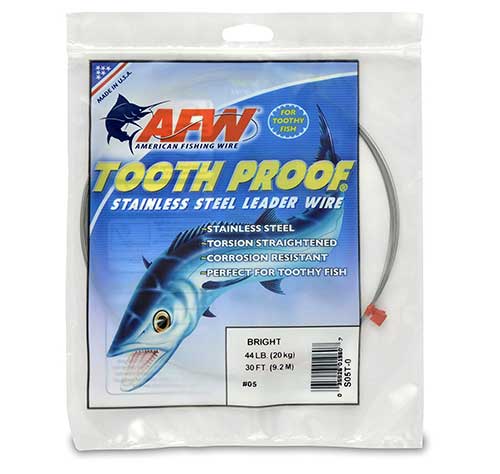
Buy from Amazon
Shop Bass Pro Shops
AFW stainless steel leader works great for most sharks. Generally, the leader is about 20 pounds heavier than the line being used. I always use number 10, which is a 124-pound leader when targeting large sharks over 5 feet in length. For smaller sharks, number 4, 38-pound wire and number 7, 69-pound wire are good options. Sharks are not that picky when it comes to the thickness of leaders. Just have a nice bait ready for the rig and if sharks are around they will typically bite.
These wire leaders are usually 3-8 feet in length. In general, you want the wire length to be the length of the shark. If the line rubs against the abrasive skin of the shark body it will cut the line. Even the shark tail hitting the line could cut it. If you do not have a wire leader and the hook is in the corner of the shark’s mouth you can often still catch the shark. You just have to tire the shark out while keeping the shark behind the boat. If you reel the shark in too quickly it will turn quickly which results in the line rubbing on the body of the shark and getting cut off.
Crane Swivel for Shark Rigs
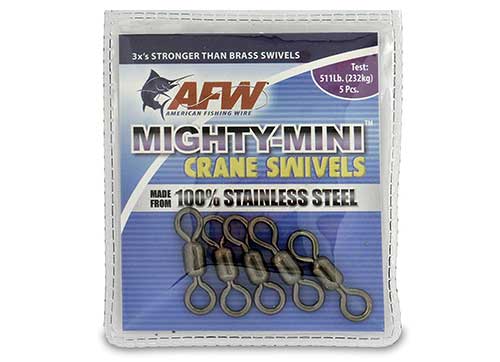
Buy from Amazon
Shop Bass Pro Shops
Crane swivels are good to use with the wire leader. These are small and are rated from 78 to 511-pound test. I would recommend getting the 511-pound swivels. These are not that big and it makes it easier when twisting the wire. One end of the swivel is attached to the wire with a haywire twist and the other is tied to the line with your favorite fishing knot. I personally use a uni-knot to tie the mainline onto the swivel.
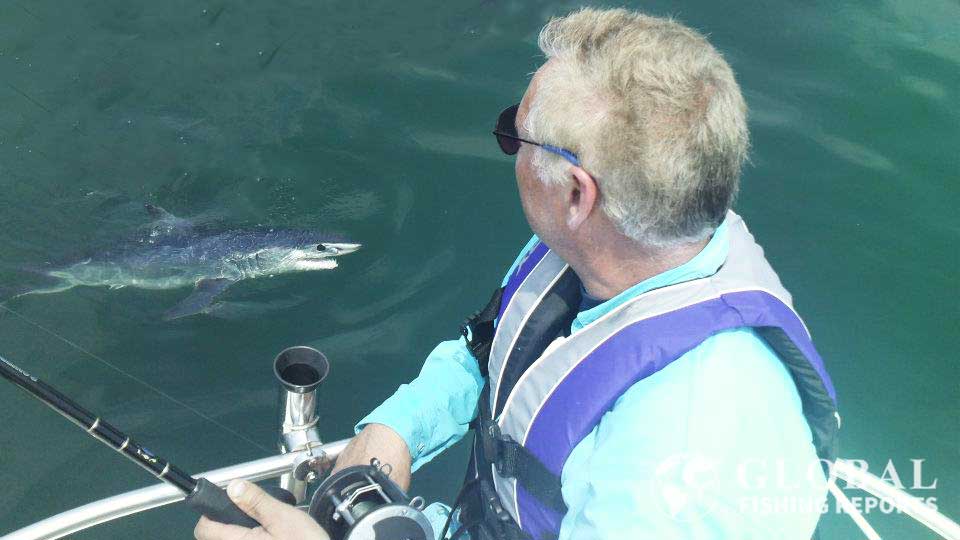
In the picture, my dad is reeling in a small mako shark that was caught and released in New Jersey.
Shark Rig: Carbon Circle Hook with Cable Rig
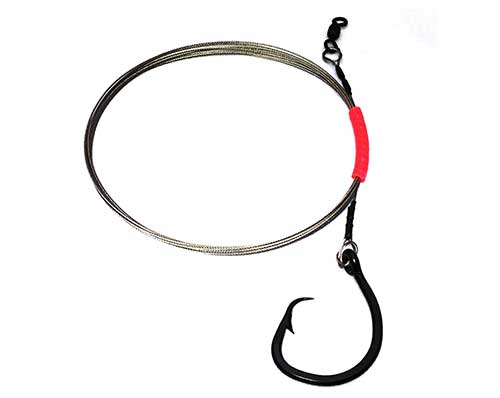
Buy from Amazon
This is a 10-foot shark leader with a 270-pound steel cable. The circle hook is a carbon steel size 16/0. I was worried that the anti-rust coating on this circle hook might take too long to rusk out of the fish if the line were to break off. I frequently see sharks with multiple shark rigs in their mouths. All of the big game circle hooks are made out of coated carbon steel or stainless hooks both of which I think will take way too long to rust out of fish given how thick they are made. This coated carbon steel circle hook would be better to use than large stainless steel hooks.
If you do use this rig make sure to scratch off the coating in a few places and remove the barb. This will make it easier to de-hook the shark during the release. I have switched to using thinner coated circle hooks and scratch the outer coating on part of the hook so it will rust out if the hook can not be removed. Most of the time the hook can be cut with a bolt cutter or pulled out using a de-hooker.
Since hooks take a long time to rust the best option is to use quality gear to catch the shark and remove the hook. The first step in this process is to file off the barb of the hook in advance. Once a shark is hooked with a circle hook it rarely gets off. To remove the hook from the shark use a large dehooker tool or bolt cutter to cut the hook. I explain how to use these tools later in this article.
If you do not know how to twist wire buying shark rigs like this will get you fishing. Below I will detail how to make your own shark rigs which is an important skill for a fisherman to know.
File To Remove Barbs and Coating on Shark Hooks

Buy from Amazon
This file is 10 inches in total length and has a 6-inch file. When a shark gets hooked with a circle hook it is almost always secured very well into the corner of the mouth. Very very rarely does a shark shake a hook loose. For this reason, there is no need to have a barb on the hook. The barb makes it very difficult to remove the hook from a shark with a de-hooker. I have done it many times but it is difficult. The barb can also be crushed with a large pair of vise-grips or pliers.
Many online videos show people struggling to get hooks out of sharks. It is best to use hooks without barbs and have a bolt cutter to cut the hook in half when releasing sharks. If you do not do these two things you should not be targeting sharks. Most sharks are released and there is no reason the leave any tackle in the fish unnecessarily.
People say that large big game hooks will rust out but this is not true. These are large corrosion resistance hooks that will take many years to rust out. I have seen plenty of sharks while diving the reef with shark rigs hooked in their mouth. Also, sometimes when catching sharks they have three or four shark rigs hooked to them. It is most important for humans to stay safe when releasing sharks. Don’t do what you are not comfortable with but also don’t target sharks if you can not release them safely.
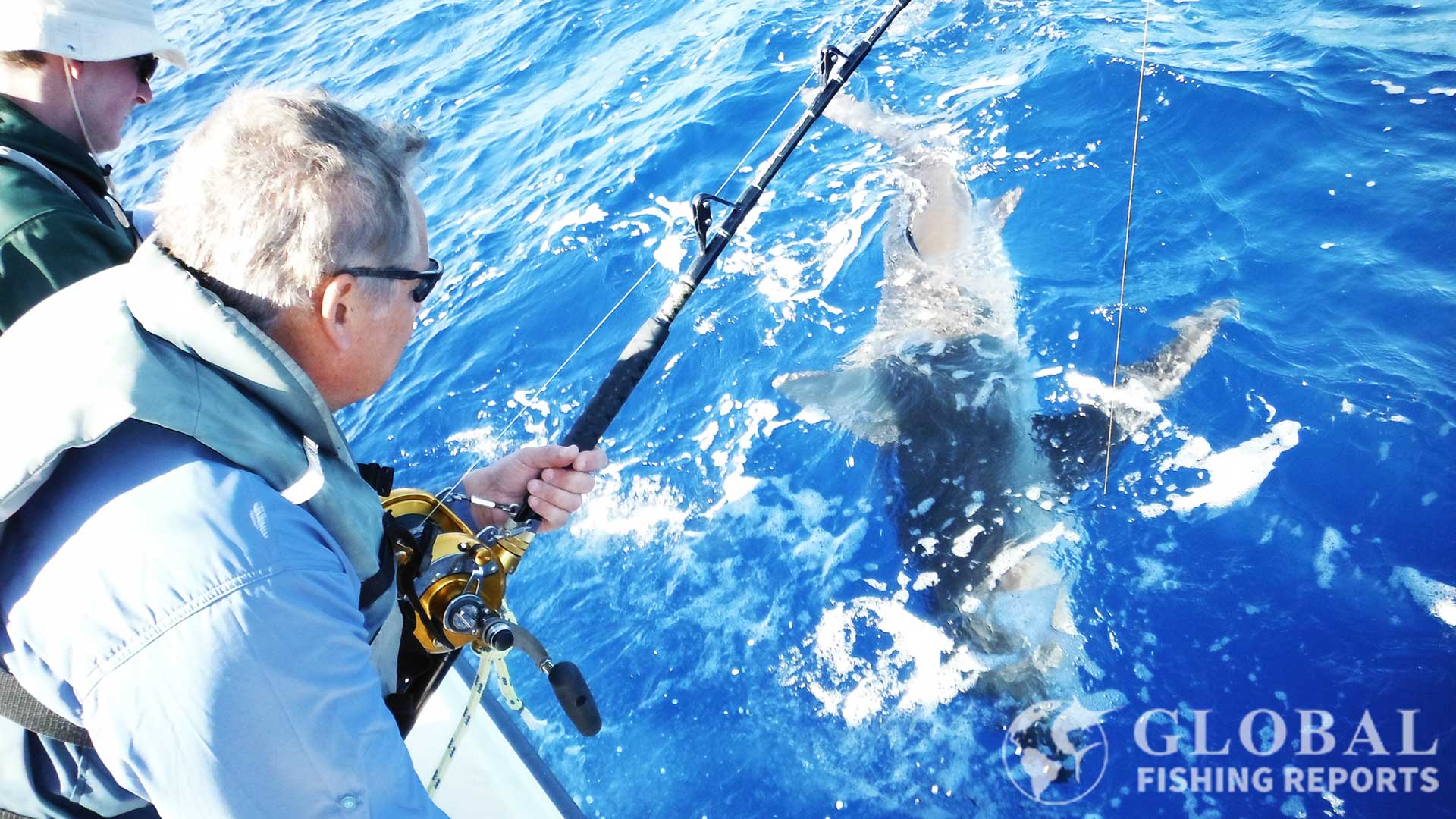
In the picture below my dad and I caught a large dusky shark. We were fishing about 20 miles offshore in the Florida keys. This is a protected shark and always has to be released.
Shark Rig: Custom Multi Strand Cable Rig
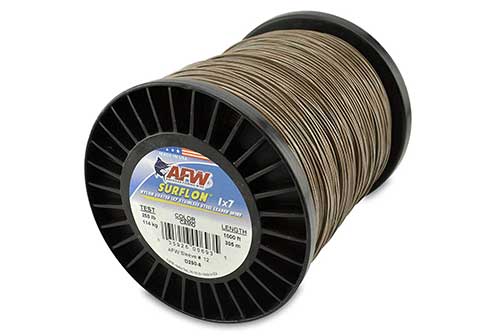
Buy from Amazon
Shop Bass Pro Shops
The multi-strand cable comes in a variety of strengths. I would recommend using cable over 150-pound strength. The cable ends up being thicker than single-strand wire. The advantage of cable is that it is more flexible. If you do not know how to twist wire then using a multi-strand cable is a good option because it can be crimped. Shark rigs over 8 feet in length are typically made with cable because it is easier to wind up and store a leader made with cable. The cable is thicker which makes it a bit easier to handle when releasing the shark. Just make sure number to wrap the leader and this can be very dangerous.
Mini Copper Double Barrel Crimp Kit
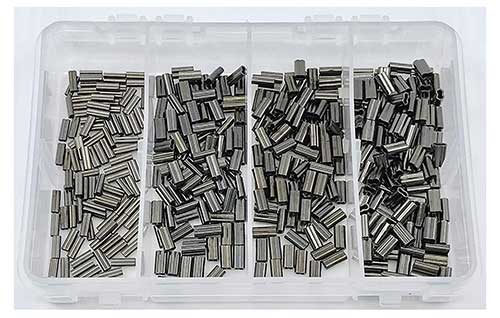
Buy from Amazon
Shop Bass Pro Shops
Mini Copper Double Barrel Crimp Kit 100 pieces. Sizes are .8, 1.0, 1.2, and 1.4 mm which are 50 to 180-pound test crimps. Typically two crimps are added at each crimp point. This adds strength to the crimp point in case one crimp were to fail. In general, crimps are very strong and are not common failure points unless the fishing rig is old.
Fishing Crimping Tool
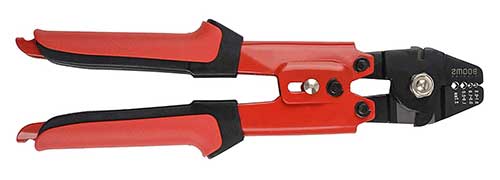
Buy from Amazon
Shop Bass Pro Shops
This is a basic fishing crimp tool. This works with single or double barrel crimps made from copper or aluminum sleeves. If you do not have a crimper you can use a large pair of pliers. Having a crimper allows the crimp to be compressed over the line evenly and with more force. Crimps are typically used on a steel cable, monofilament line, or fluorocarbon leaders over 80 pounds in line strength. This is because it is difficult to tie knots when using thick lines.
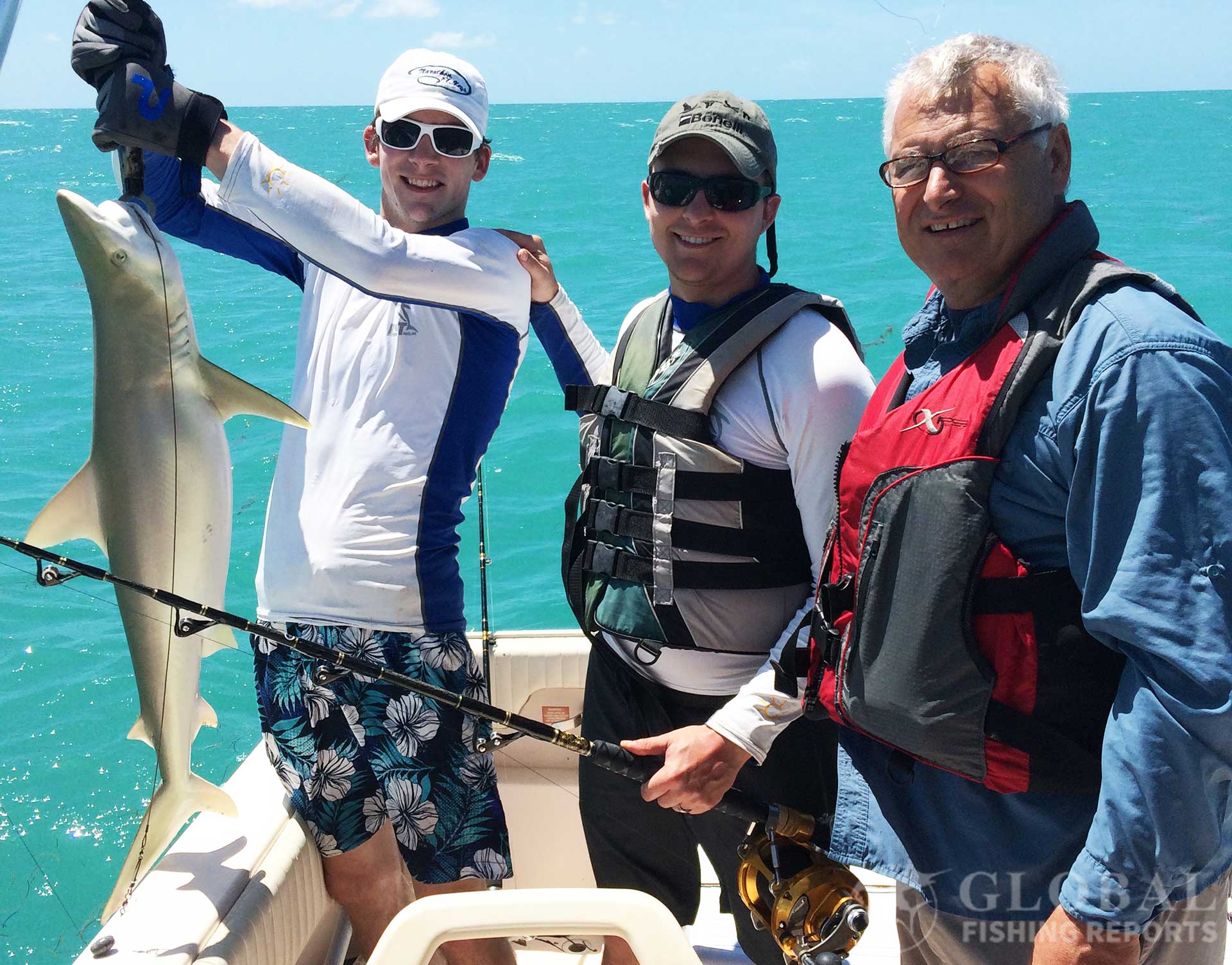
In the picture, we caught a reef shark while fishing in the Gulf of Mexico in Florida. The shark was safely released.
Shark Rig: Stainless Steel Circle Hooks with Wire Leader
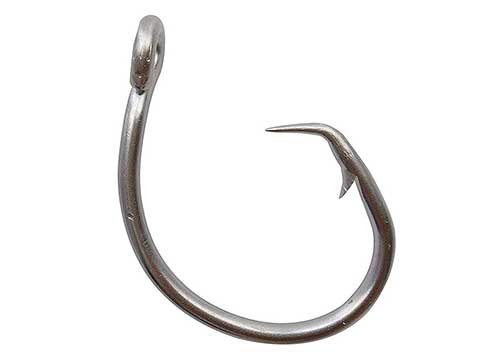
Buy from Amazon
Shop Bass Pro Shops
This is an Owner Super Mutu Circle Hook. Size 16/0 is a good size for sharks that are 8 feet in length or larger. It is a good idea to know what size shark is being targeted. If a spinning reel with an 80-pound line or less is being used to catch small sharks under 8 feet a thin wire circle hook would be the best option. It makes removing the hook much easier. When releasing the shark the hook should be removed or cut in half with a pair of bolt cutters. This hook is stainless steel so there is no coating on it. However, the material itself is corrosion resistant so it may take years to rust out of a shark.
Circle Hooks are the way to go for most shark situations. These hooks help prevent the shark from getting hooked deep in the mouth or gut. Even with circle hooks, the drag should be tightened up quickly once a shark is pulling the line off the reel. In the Gulf of Mexico, circle hooks are always required by law.
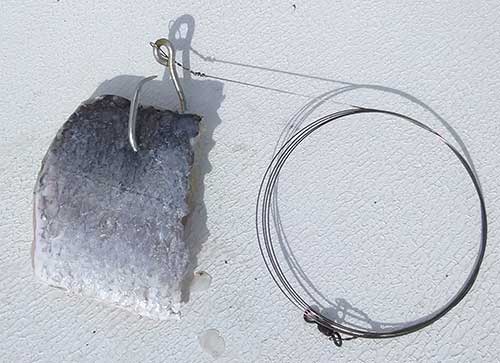
The best bait for sharks is Barracuda. If we catch a barracuda I fillet it and cut it into about 4-inch sections. I put this bait about 20 feet off the bottom in clear water and about 5 feet off the bottom in murky water. Even without chum, this will still catch sharks on most fishing trips. I always ask people if they want to catch a shark. Some people do not know what is involved. Sharks are very strong and usually take over 20 minutes to reel in. This can cut into fishing time to catch dinner if that is what people are wanting on the trip.

In the picture is a blacktip reef shark that we caught and released safely in the USVI.
Shark Rig: J-Hook Shark Rig

Buy from Amazon
Shop Bass Pro Shops
This is a Mustad 3407 classic saltwater hook. Size 12/0 is a good size for sharks. Typically size 7/0 is used for mahi-mahi and tuna fishing. This hook is made of carbon steel which is better than stainless steel in my opinion because eventually, it will rust out of the fish if the line breaks. These hooks are zinc plated and it still may take years to rust out. It is best to remove the hook or cut the hook with a bolt cutter. In some states, J-hooks are against the law to use for sharks like in New Jersey and in the Gulf of Mexico in Florida. Check local regulations before using J-hooks for sharks.
J-hooks work best when the shark can be seen from the boat and the bait is basically pitched to the shark. This way when the shark takes the bait the drag can be tightened quickly so it gets hooked in the corner of the mouth where it will be easier to remove the hook. If you do not see the shark using a large circle hook is the better hook option. This is because you do not want the shark to swallow the bait and get gut-hooked.
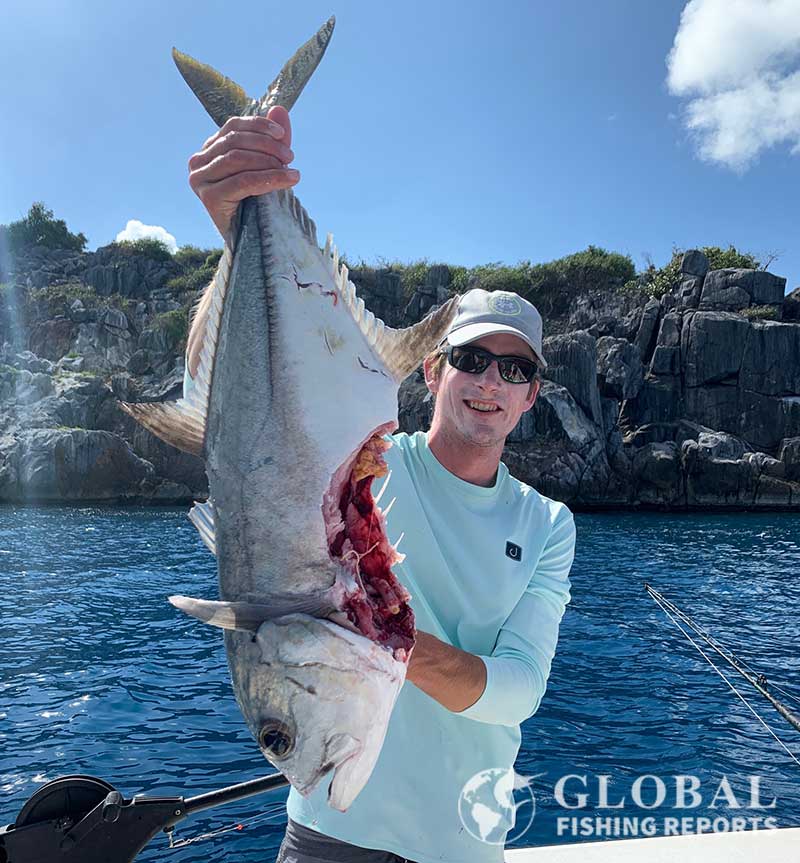
In the picture is a large horse-eye jack that we caught in the USVI. While it was being reeled in a shark took a bite out of it.
Shark Rig: Suspend the Bait on a Float or Balloon

Buy from Amazon
Shop Bass Pro Shops
This style shark float comes in a 9-inch Sea Strike version and a 6-inch AFW version. When a large weight is not being added to the rig a 6-inch float is a good size. If a large 8 ounce plus size weight is used the 9-inch float is a better size.
Shark floats or balloons are a good way to suspend and separate baits when shark fishing. Oftentimes baits near the surface are not the best but a bait can still be sent deep but placed on a float to help separate the fishing lines.
The reason I do not recommend doing this is because tension is often not quickly applied to the fish and it will get gut hooked. Floats are good to use in shallow water as anglers usually recognize immediately that they have a bite. So if using a float in deep water make sure to not suspend the bait too far from the float. I would say at most 15 feet.
Shark Rig. Add Weight to Fish Deeper
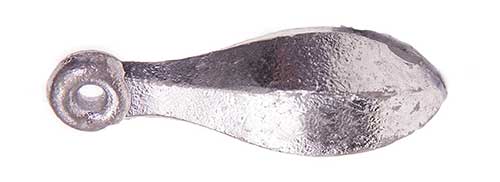
Buy from Amazon
Shop Bass Pro Shops
These egg weights or bullet weights are a great way to send the shark rig down deep. In the picture above you can see that I was using a 4-ounce weight that I tied with a dropper loop to the line. This is a great way to add weight to a shark rig. Some people attach the weight to the line with a rubber band. Other times I send the rig down to depth with a downrigger. The downrigger works well in a strong current but when there is little current the rigs can easily get tangles around the downrigger wire.
People often wonder what is the best depth to fish for sharks. If you are chumming it is good to have a line near the surface. In general, sharks stay and feed near the bottom in water shallower than 200 feet. When the water is clear blue water, I try and keep the bait about 20 feet off the bottom. In murky green water, I try to keep the bait about 5 feet off the bottom.

In the video below, I show how to tie a haywire twist and the best way to tie a dropper loop.
Shark Baits
Shark Bait: Barracuda Shark
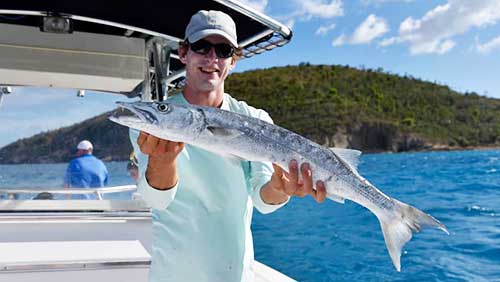
Barracuda are frequently caught when fishing in warm water in Florida and the Caribbean. It also happens to be the best best for shark fishing. Some people eat barracuda but in the Caribbean, it is not eaten because of the risk of ciguatera poisoning. The fillets cut into 4 inches pieces are perfect when fishing for most types of sharks.
It has a strong scent that sharks are very attracted to and it stays on the hook very well. In Florida, only one fish over 36 inches is allowed to be caught per vessel so make sure not to keep multiple large barracuda. Each angler can keep two barracuda per day but they have to be under 36 inches. Barracuda fillets work well even after being frozen.
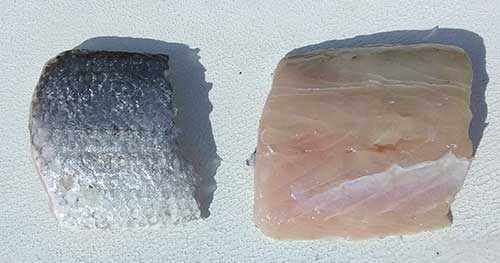
In the picture above are two chucks of barracuda fillets I made for shark fishing. These were placed on large circle hooks and fished near the bottom. Typically I would not even chum for sharks and would still get a shark to bite about once a day while primarily fishing for other types of fish. There are lots of sharks in Florida and in the Caribbean.
Shark Bait: Bonito

Bonito and skipjack tuna are the favorite food of many offshore shark species. Some days it is difficult to reel in a tuna or bonito without it getting eaten by a shark. In the picture, my sister has a skipjack tuna that got bitten by a shark while she was reeling it in.
Bonito have dark red bloody meat that has a strong scent to attract sharks. When fishing with bonito a large chunk can be used or a piece of the fillet. Sharks are not typically picky eaters or leader shy when a good bait is in front of them. Don’t let the shark take the bait too long or they can get gut hooked which will likely kill the shark unnecessarily.
Shark Bait: Menhaden also called Bunker
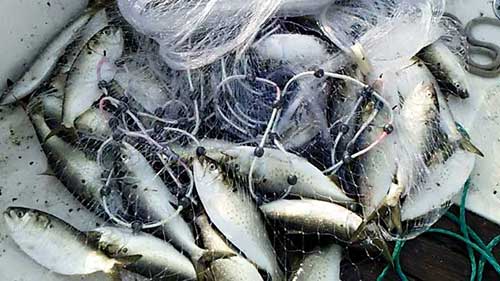
Bunker also called menhaden is a great bait for most predator fish and shark is no exception. This is a very oiling fish and the menhaden oil is commonly mixed in chum to help attract fish to the boat. Bunker swim in large schools and can be caught with a snagging rig or cast net.
Shark Bait: Mullet
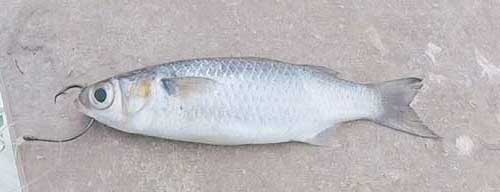
Buy from Amazon
Mullet is a very common bait in Florida and in the Caribbean. It is one of the most popular baits for tarpon fishing but also works well when shark fishing. This bait can be butterflied by cutting off the tail and cutting a few inches of the fillets on both sides starting in the back. It can also be used as bait in chunks. Brined mullet can be purchased in sealed packages but fresh mullet is best. Mullet can be frozen and thawed out and still work really well as fresh bait.
Shark Bait: Ballyhoo
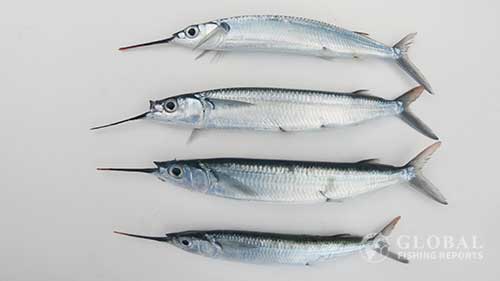
Many people do not think of ballyhoo as shark bait but it certainly works. It is not uncommon to have small sharks bite ballyhoo while trolling on the reef for mackerel. Ballyhoo is a bait that is commonly found fresh and frozen in bait stores. If you can’t catch your own bait with a cast net then this is a good option.
Shark Bait: Baitfish, Pilchards, Herring, Goggle Eye
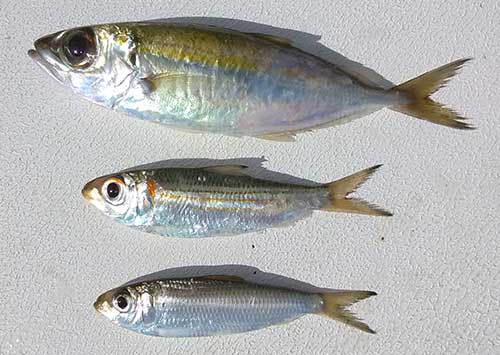
Sharks will bite most types of baitfish. Above is a goggle-eye, scaled herring, and pilchard. All of these will work dead or alive to catch sharks. When using smaller baits it is a good idea to use a smaller hook. Sharks are not leader shy but a minnow on a large hook does not look quite right. Using a small J-hook with number 4, a 38-pound wire would be good for sharks under 3 feet and number 7, a 69-pound wire would work for sharks 3-6 feet in length.
Shark Bait: Squid
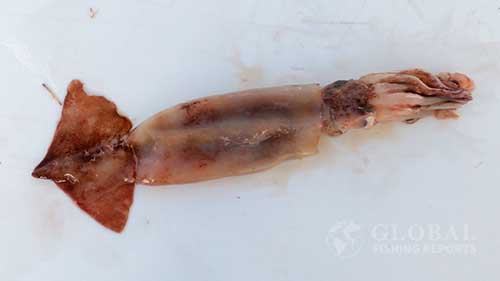
Another shark bait that many anglers overlook is squid. While it would not be my first choice it is not uncommon to catch sharks when fishing with squid for other types of fish. It is good to use a large piece of squid to get the shark’s attention. Frozen Squid is sold in boxes at most tackle shops.
Shark Fishing Gear
Shark Chum Bags
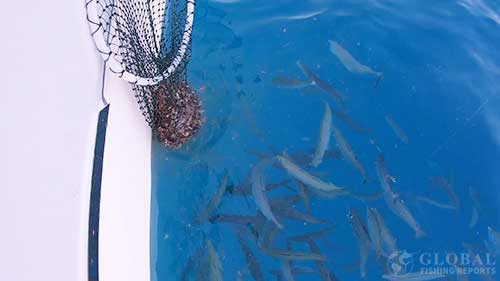
Buy from Amazon
Shop Bass Pro Shops
The DU-BRO Fishing Easy Load Chum Bag has a 14-inch diameter opening with a 6-foot rope.
A chum bag is a must-have when targeting sharks. Sometimes catching other fish brings sharks to the area but most times chumming is needed to attract sharks and other fish to the area. Once chumming starts sharks typically show up in 15 minutes to 1 hour. After 1 hour if no sharks show up it is a good idea to move to a different location. The boat should be anchored when chumming otherwise there will not be a good scent trail leading back to the boat. Try and have baits in the chum slick, near the surface, and deep near the bottom.
Sharks can easily be missed if baits are not at the right depth. Fishing for sharks can be relaxing with some downtime while waiting for a shark to show up. Even though the chum is at the surface put baits at different depths. Baits near the bottom catch the most sharks.
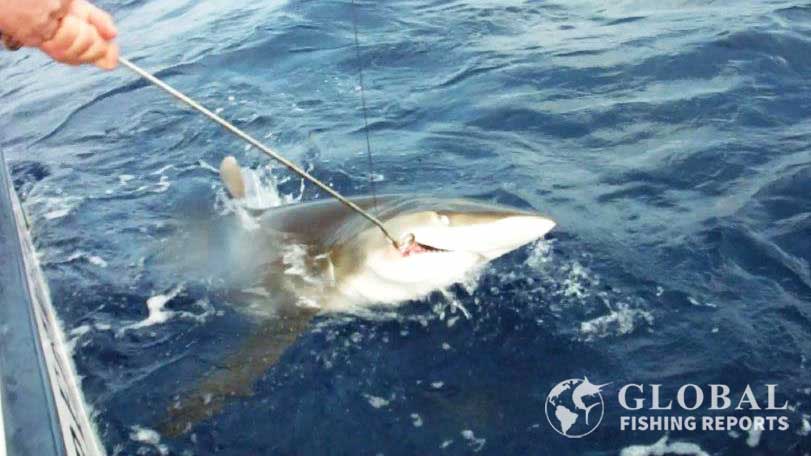
In the picture, we are using a dehooker to release a Silky Shark in the Florida Keys. The barb was on the hook making it difficult to release.
Bolt Cutter to Remove Shark Hook
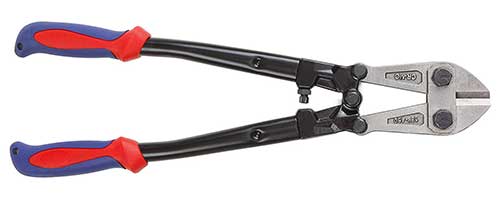
Buy from Amazon
Shop Bass Pro Shops
Having this 24-inch bolt cutter on the boat is a great idea and should be required when shark fishing. You do not want to just cut the leader you want to cut the hook. Leaving hooks in sharks or any fish is a bad idea. Rather than wrestling the shark into the boat to remove the hook, you can cut the hook with the shark in the water. Make sure the bolt cutter is stored in an area free from saltwater or it will rust.
It is also a good idea to file the barb of the hook when shark fishing. This will make it way more likely that the other half of the hook will work itself fee. Also with a barb-free hook, the shark can likely be released with a large de-hooker.
ARC DeHooker Big Game Hook Remover

Shop Bass Pro Shops
This ACR De-hooker comes in 24-inch and 34-inch sizes. De-hookers are a great way to remove hooks from fish. This is also true for sharks. Hands should never be near the mouth of a shark during the release. Use extreme caution when releasing sharks. Wear protective gloves when handling the leader.
To remove the hook tension should be added to the leader line and the hook should then be pushed forward with the Dehooker. This should dislodge the hook. After the hook is free tension should remain on the leader and Dehooker while the hook and Dehooker are removed from the shark’s mouth.
If this does not work cut the hook in half with a pair of bolt cutters. The last option should be to cut the leader itself with a pair of wire cutters. Hooks take a long time to rust away and depending on where the hook is located it can cause problems for the shark.
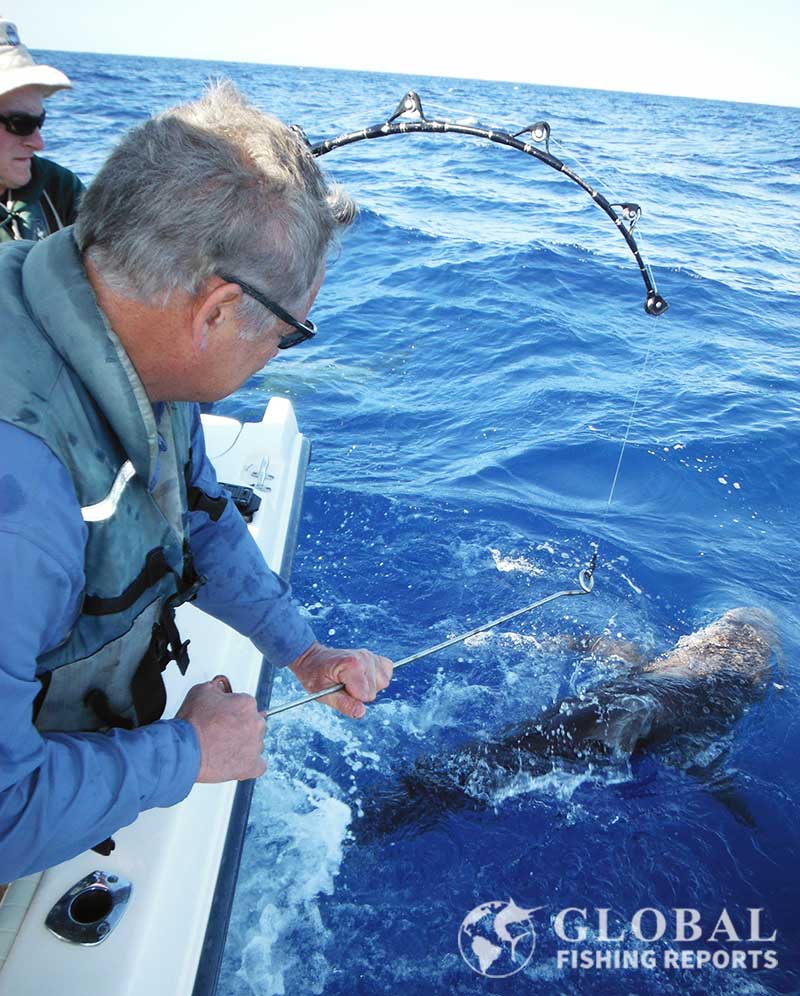
Shark Fishing Techniques
Sharks are typically caught by anchoring a boat and putting out chum to create a scent trail. With a nice current, the chum can attract sharks from miles away. If there are large schools of fish sharks are frequently found in the area. One bait should but put near the surface on a float or balloon. Another bait should be sent deep near the bottom. Most of the sharks I have caught were near the bottom. Sharks are caught higher up when scent or splashing gets their attention.
The bait should be put on a shark rig with steel wire or steel cable that is longer than the shark as discussed above. Anglers do not need a huge hook to catch a large shark. That being said sharks are not typically shy of exposed hooks or thick leader lines. The key is to have fresh bait. Take a section of fillet off a barracuda or bonito and you have great bait. Live injured bait does get the shark’s attention and can get a bite if another bait is not working.
Use large conventional fishing reels with quality drag and line over 50 pounds in strength. If you are using a small reel and light line a large shark is going to break the line or spool the reel. The result is the fish is not caught and litter is put into the ocean. If you are going to fish for a shark do it the right way, catch the fish and release it safely. The best way to release a shark is to cut the hook with a bolt cutter. If you are experienced you can quickly remove the hook with a dehooker if the bard is filed off the hook. Make sure to never wrap your hand around the leader because this is dangerous for multiple reasons. Wearing gloves during the release process is a good idea.
Common Questions about Shark Fishing
What is the best bait to use for sharks?
A fillet of fresh barracuda is the best shark bait in the world. Bonito also makes great shark bait because the meat is bloody and has a strong scent. Any baitfish will work as well such as mullet, herring, pilchards, bunker, ballyhoo, etc. Most fresh fish will get sharks to bite. The only bait I have struggled to catch sharks with was catfish. Live bait works great as well. Many times sharks will eat the live bait you have set out for other game fish being targeted.
Is it legal to harvest sharks to eat?
I would strongly recommend releasing all sharks. There are both federal and state regulations for sharks. Some species of sharks can be kept to eat if they are over 54 inches in length. This length is to the fork in the tail, not the total length. If you are going to keep a shark to eat learn how to properly identify sharks. There are many species that look very similar to each other. One might be legal to keep and the other might be endangered. If it is the fish shark you ever caught, let it go. It will be a much better experience for you and the shark.
What is the best time of day to catch sharks?
Most people think that nighttime is the best time to catch sharks. In general, this is correct. Sharks are more active at night. Shark fishing can be very location and tide-dependent. Sharks are out deep during the day and can be easily caught if you put bait in front of them. Changing tides allows for better scent trails and more bites. The sharks are typically out deep during the day and might feed closer to shore during the nighttime. This is why many people surf fish for sharks at night.
What is being taxed by a shark?
Getting taxed by a shark is when a shark eats the fish that you are reeling in. Hammerhead sharks eating Tarpon and Dusky sharks eating tuna are not uncommon when fishing in the ocean. Most times you do not get to see the shark when you get taxed but the line starts peeling off the reel and then gets cut. Other times you reel in the head of a fish and know exactly what happened. Location and time of year are important factors that determine the number of sharks and the species of sharks that are around when shark fishing.
Captain Cody has worked on charter fishing boats in the Florida Keys, Virgin Islands, and Alaska. Growing up in Pennsylvania Cody has also done extensive freshwater fishing including bass fishing tournaments. Cody strives to provide detailed information about the best fishing gear and tactics to help both novice and experienced anglers have a more productive and enjoyable time on the water. Cody also has a background in aerospace engineering and neuroscience but really only takes pride in being good at one thing and that is fishing!
How To Identify Shark Teeth
Once you find a shark tooth the next step is to identify what type of shark it is from. Some large teeth like the Megalodon and great white shark are easy to identify. There are over 500 species of sharks and smaller shark teeth can be more difficult to identify. Looking at the jaws of sharks gives a good idea about the different shapes of teeth there can be for the upper and lower jaws. A single shark can actually have very different shaped teeth depending on the location within the jaw.

The photo above shows the teeth of the megalodon, great white, snaggletooth, sand tiger, thresher, tiger, hammerhead, bull, and lemon shark. These are what most people would consider the textbook shape teeth for each type of shark. However, even within these basic sharks, there are older extinct species that were very similar. So doing more research can provide insight into the type of shark tooth and the age of the shark tooth.
Tiger Shark
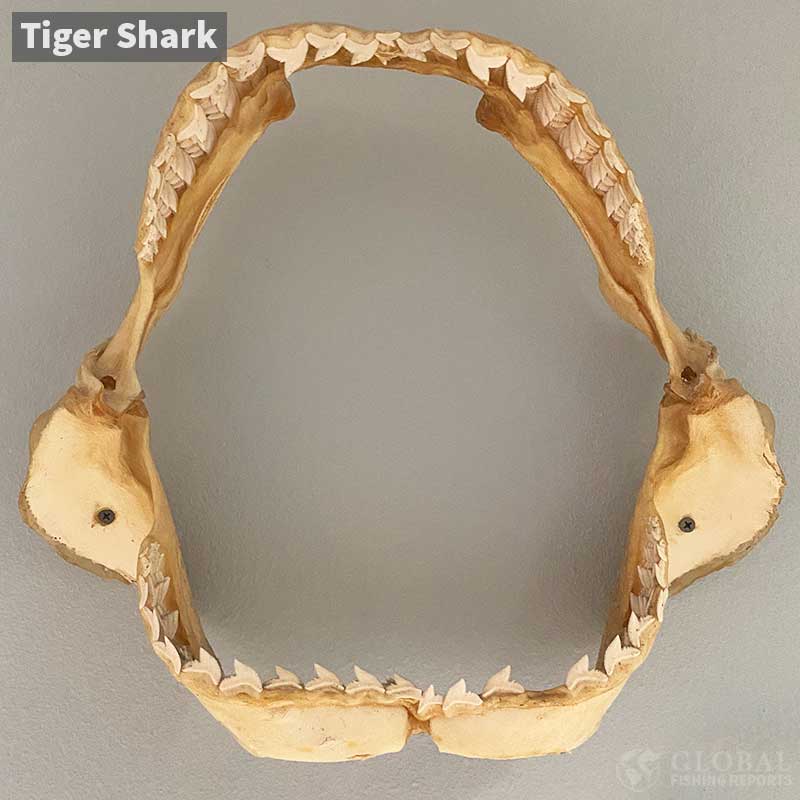
Tiger sharks are large sharks that can grow to be over 16 feet long and weigh over 1,700 pounds. These sharks are found in warm waters in Florida, on both coasts of Mexico, Central America, South America, Africa, Australia, and off the coast of South Asia.
The teeth of a tiger shark are very unique and have a similar shape on the upper and lower jaw. A wide base and long edge make the teeth excellent for cutting through fish. Below the point of the tooth is a lower serrated section of teeth which allows for additional cutting. Tiger sharks are known for feeding on lots of different types of prey including fish, sea birds, dolphins, adult sea turtles, sharks, rays, seals, sea lions, and even whales.
In the photo above you can see many rows of teeth behind the primary front row. When the shark bites into prey the teeth can dislodge and teeth from the back rows move up to replace the front teeth. This helps ensure the shark always has strong sharp teeth to help catch and eat whatever type of prey they encounter.

The photo above shows the upper jaw of a tiger shark. While all the teeth have the same unique shape the front teeth are much large and get smaller toward the back of the jaw. There are several extinct species of tiger sharks with similar but slightly different shapes and serrated edges. Some of these species such as the G. Latidens lived in the Eocene epoch over 33 million years ago.
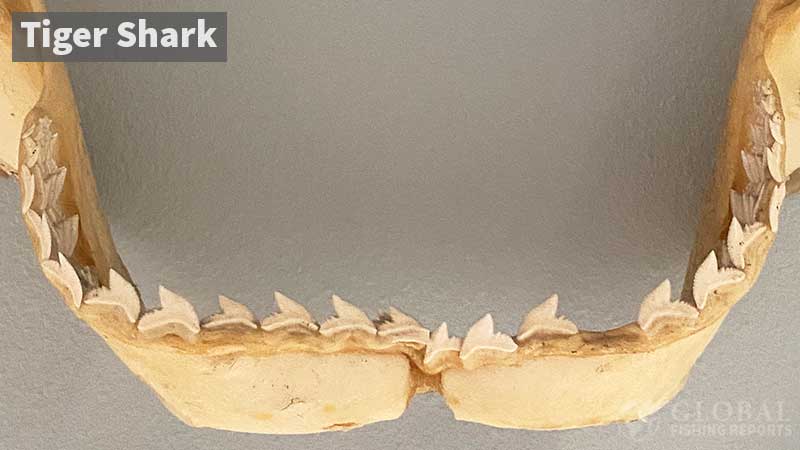
A tiger shark’s lower jaw can be seen above. The teeth are slightly smaller than the top teeth and point in the opposite direction. This different direction of the top and bottom teeth allows the shark to cut into its prey like a saw that cuts as the shark shakes its head. The overall jaw shape is very wide even for a shark which helps grab and eat large prey.
Lemon Shark

Lemon sharks are average size sharks that can grow to be over 11 feet long and over 400 pounds. A lemon shark has a classic t shape tooth with a sharp point. This is a very common shark tooth to find on the beaches in southwest Florida. Lemon sharks are very prevalent in the Florida Keys and in the Gulf o Mexico.
The teeth on the bottom jaws of many other sharks including the bull shark, dusky shark, blacktip shark, silky shark, bonnethead, sandbar shark, and others look very similar to lemon shark teeth. For this reason, many people find teeth and call them lemon shark even though they very well may be from a different type of shark. The teeth of a lemon shark are fairly thin, curve inward slightly, and have a wide base.
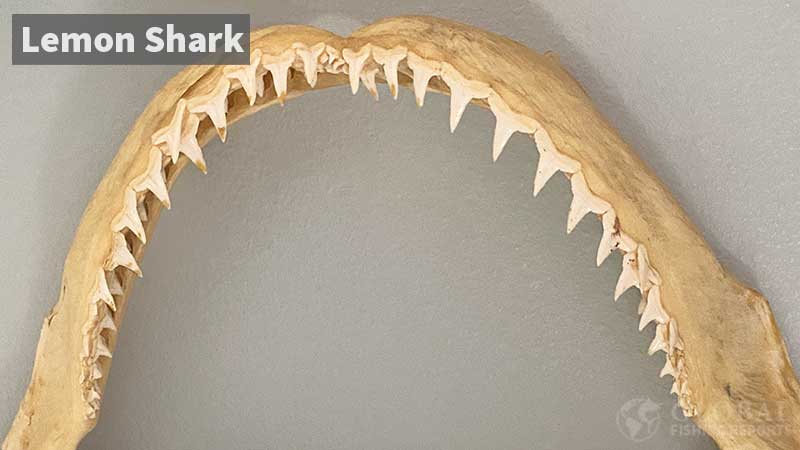
The top jaw of a lemon shark has teeth that are slightly larger than the bottom teeth but have the same shape. There are many rows of teeth behind the front row as well. These are not typically exposed but are under the skin and in cartilage. The sharp pointy teeth of a lemon shark cut into the fish or prey as the shark bites down. Near the wide base of the tooth, the two top edges are also sharp and slant back slightly. These are also cutting surfaces that allow the lemons shark to make clean bites.
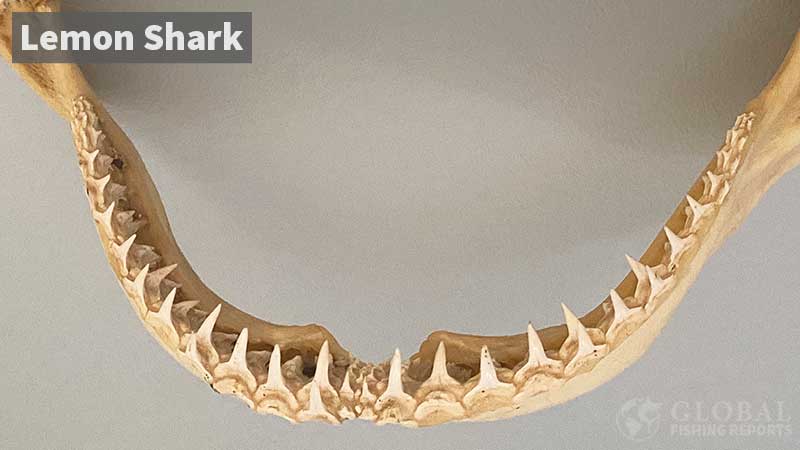
On the bottom jaw of a lemon shark, the teeth look similar to many other sharks. This could mean the species are closely related or that sharp pointy teeth are advantageous for catching and eating fish. Behind the front rows, there are many other rows of teeth ready to replace any that are lost when feeding.
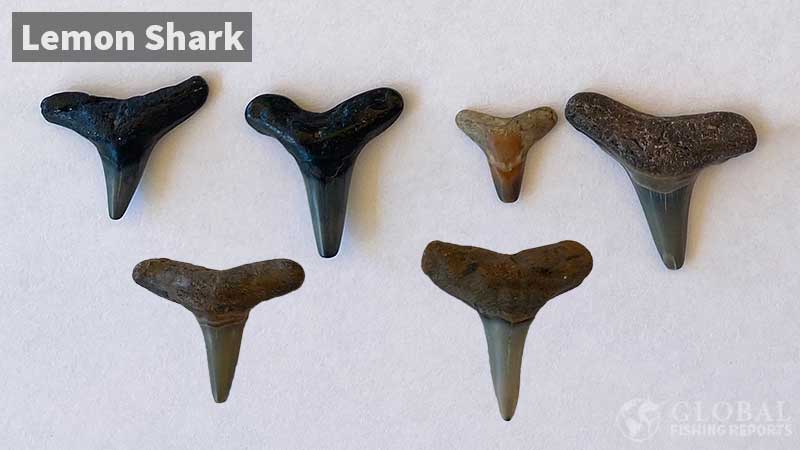
The teeth shown above are fossilized lemon shark teeth. These were found at the beach in South Florida. The color of the tooth varies depending on the type of sediment it settled in when it was being fossilized. It takes over 10,000 years for a shark to become fossilized and shark teeth can be found that are over 30 million years old.
The exact shape of the tooth varies depending on whether it was from the top jaw or lower jaw. The shape can also vary depending on how the tooth is worn. Since this shape is common for bottom teeth of other sharks it is actually difficult to say for certain these are lemon shark teeth. They do have the characteristic size and shape of lemon shark teeth though.
Bull Shark
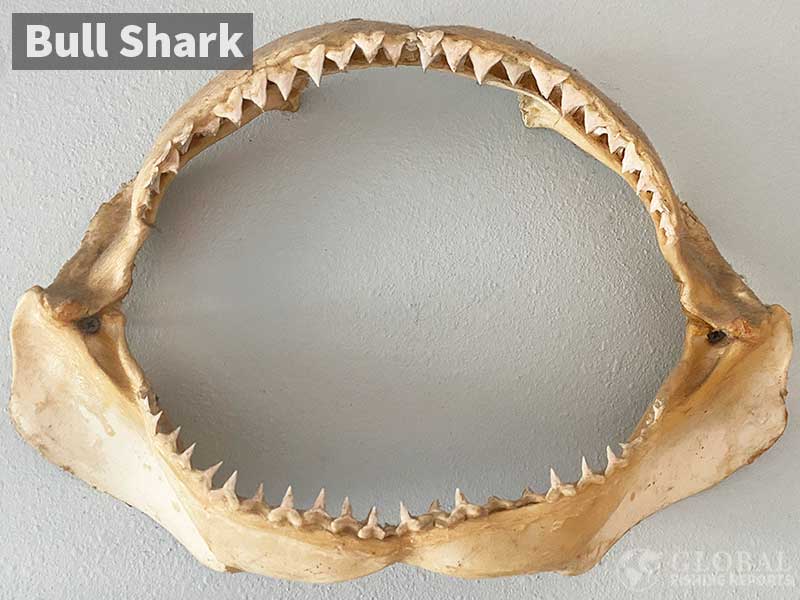
Bull sharks are large sharks that can be over 600 pounds and 12 feet long. The mouth of a bull shark is wide similar to a tiger shark. Bull sharks are a top predator in the ocean feeding on other fish, sharks, stingrays, birds, turtles, and even dolphins. These sharks are commonly seen by snorkelers and divers on reefs and shipwrecks. Bull sharks tend not to be pelagic fish and stay in shallower waters less than 500 feet deep.
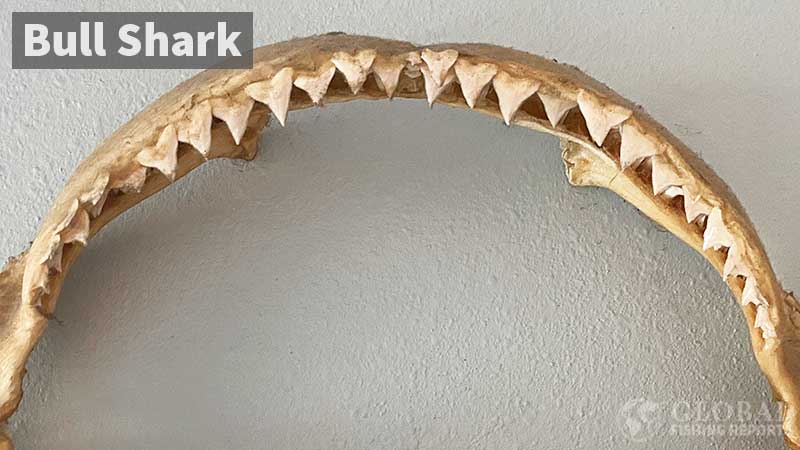
The top teeth of a bull shark are pretty unique with one side slanting down evenly and the other side of the tooth slanting at a shallow angle and then midway going to a sharper slanting angle. Some teeth near the center of the jaw slant evenly on both sides and resemble great white shark teeth.
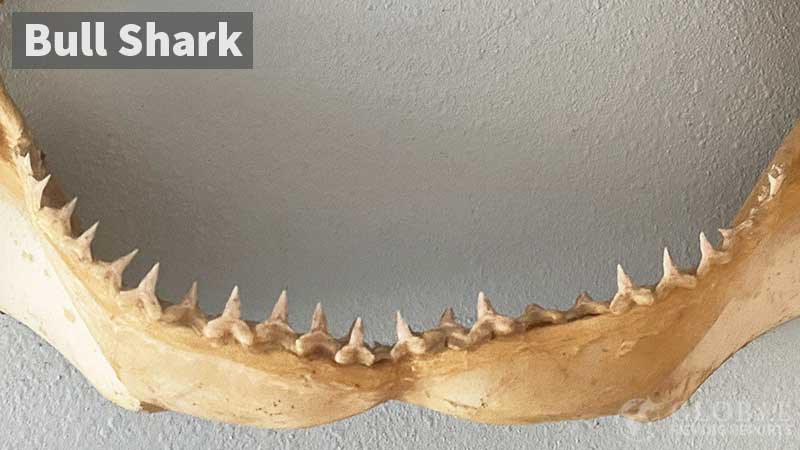
The bottom jaw of a bull shark has teeth that look similar to many other sharks. When you find a bottom bull shark tooth at the beach it is difficult to say that it is a bull shark tooth for sure. It also looks like a lemon shark tooth or a blacktip shark tooth.
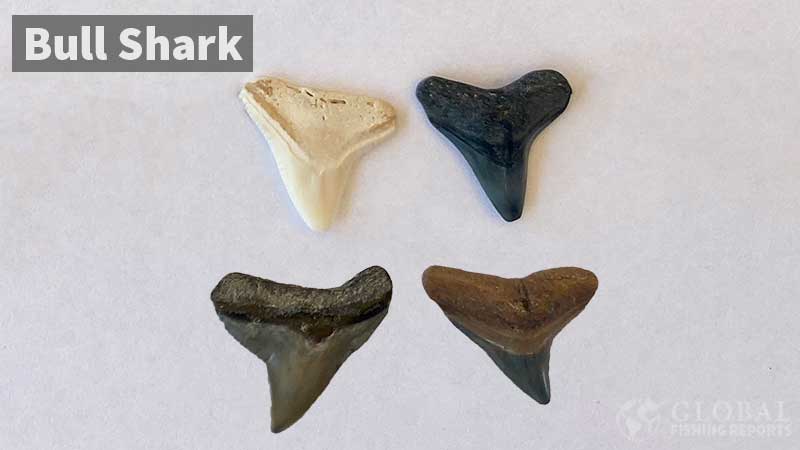
The teeth above are from the top jaw of a bull shark. On the upper left, the tooth has not been fossilized yet and is still white in color. The other teeth are fossilized and all look slightly different. All the teeth have the same overall shape which is how they can be identified as bull shark teeth.
Dusky Shark

Dusky sharks are classic-looking sharks that are typically found offshore in pelagic waters. These sharks can go in shallow waters near the coast as well but this is less common. When fishing offshore in the keys for tuna and bonito it is common to have one or more dusky sharks following the school. Dusky sharks are a protected species of shark and must be released if caught.
These are large sharks that can grow to 14 feet in length and weigh over 750 pounds. Dusky sharks can be found off the east coast of North and South America from Maine to southern Brazil. It is important that these sharks are protected because they do not reach sexual maturity until 20 years old. So fishing can put the species at risk even more so than other sharks.
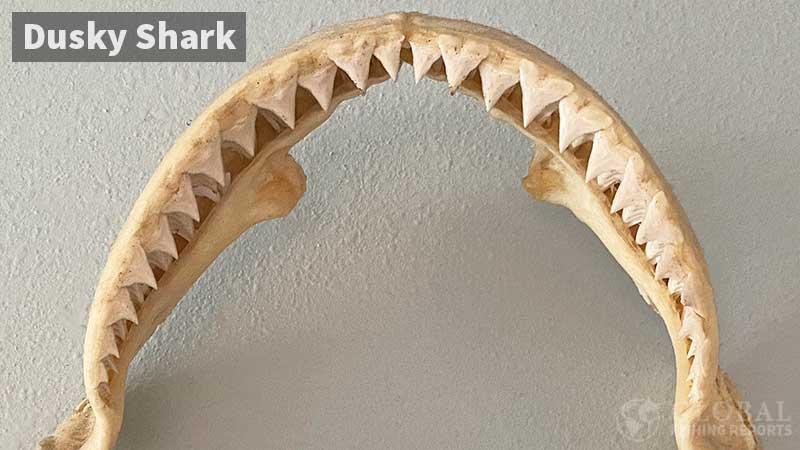
Above is the top jaw of a Dusky shark. The teeth are very similar in shape to bull sharks. It is possible that this is a bull shark jaw. However, the jaw is not a wide oval shape like a classic bull shark jaw. In the front, the teeth have a triangle shape similar to a great white. Moving out toward the side of the jaw the teeth change shape and have the classic bull shark or dusky shark tooth appearance.

Looking at the side view of the jaw you can see 7 or more rows of almost full-size teeth. On a shark typically only the first row is exposed. If one of the front teeth falls out when feeding then a tooth from the back row moves forward. This makes it so the shark always has sharp white teeth.
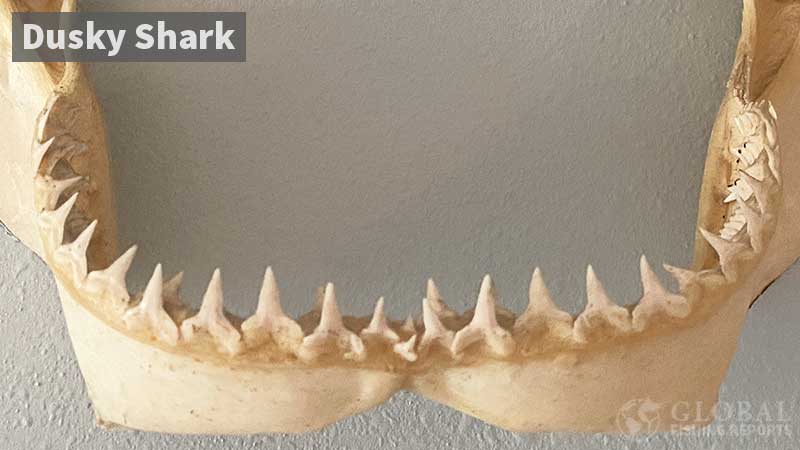
The bottom teeth of a dusky shark are sharp and pointy similar to bull sharks, lemon sharks, and blacktip sharks.
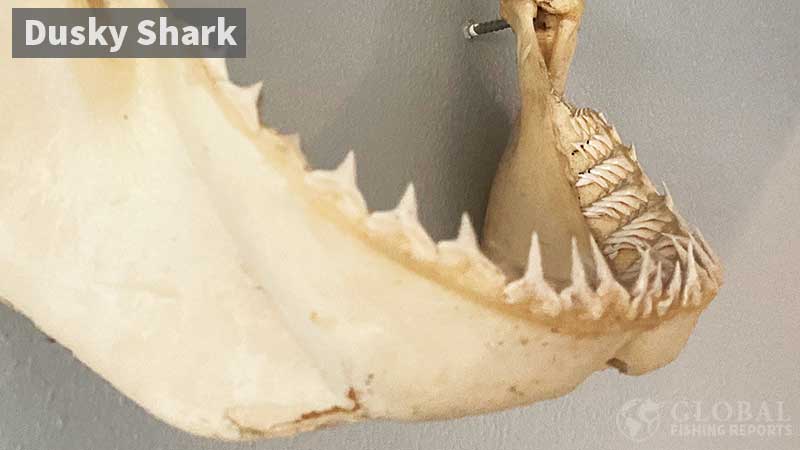
On the bottom jaw, there are 6 distinct rows of teeth. The teeth in the very front are positioned vertical ready to be used. Each row behind the front row is angled back slightly. If the front tooth is lost the next tooth in the row will slide forward and be positioned vertically. Because sharks have so many teeth and there were so many sharks alive in the past 30 million years it is actually not difficult to find shark teeth at the beach.
Megalodon Shark
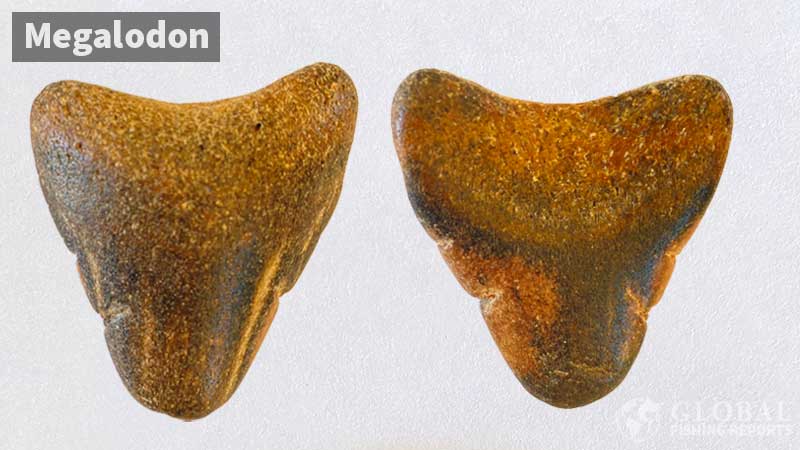
Megalodon sharks when extinct over 3 million years ago. So when you find a Megalodon shark tooth you know that it is really old and a unique find. The exact size of these sharks can only be estimated. Maximum size estimates range from 52 feet long and 105,000 pounds to 67 feet long and 227,000 pounds. This would be nearly twice the weight of an average humpback whale. The average size of a megalodon is estimated to be closer to 34 feet long.
Just like all other sharks, the teeth of megalodon varied based on age and location within the jaw. A megalodon tooth has been found that was over 7-inches in length. However, most megalodon teeth are not this large. If you find a tooth is the shape of a great white and is slightly larger and thicker it is probably a megalodon tooth. Many people seem to find well-preserved large teeth. However, these teeth are over 3 million years old so finding ones with a more aged appearance is also common. Especially if they are found on a beach.
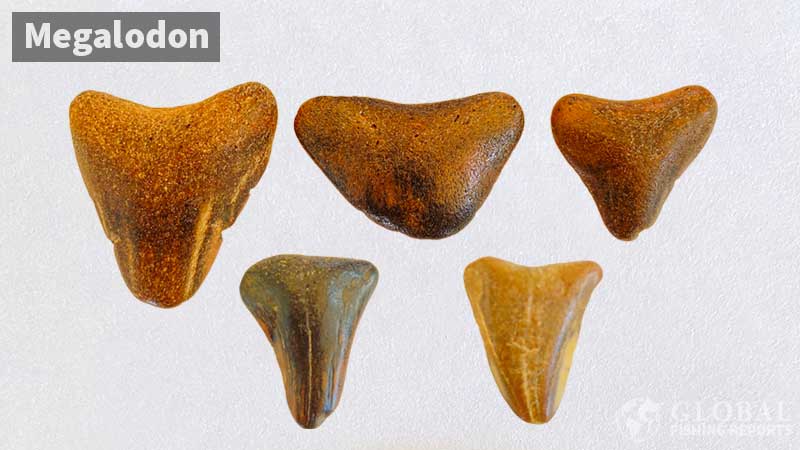
All of these teeth were found in South Florida on or near the beach. The teeth have the characteristic size and shape of a megalodon tooth. Being in the surf can slowly wear away the tooth. So when looking on a beach do not expect to always find a perfect tooth but one that is worn down but is still the shape of a large tooth.

In the photo, I am standing next to a large Megalodon tooth that is on display. This is what most people think of when they think of a megalodon tooth. If these teeth did not exist many people probably would not even believe that a shark this large ever existed.
Great White Shark
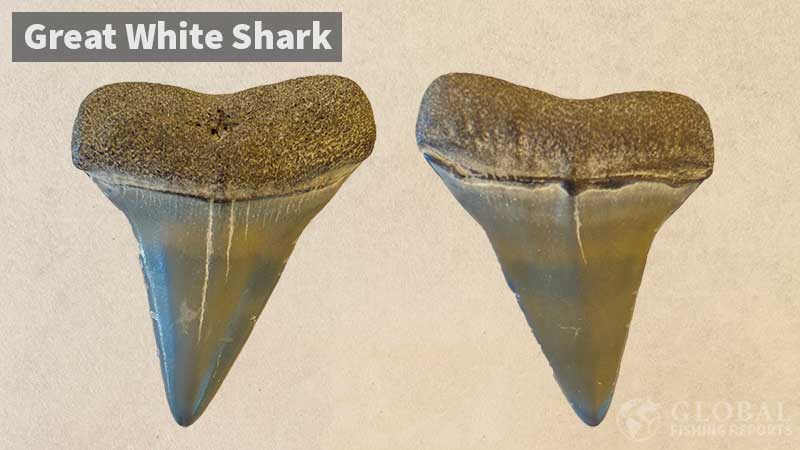
Most people are familiar with the great white shark. These sharks can grow to be 20 feet and length and weight up to 5,000 pounds. The IGFA world record catch for a white shark is 2,664 pounds. In the united states, it is against the law to target great white sharks when fishing. Sometimes they are caught when shark fishing for other types of sharks though.
Great white shark teeth are a highly desired fossil to find. The upper and lower teeth of a great white have a similar shape. Some people might confuse the very front teeth of a bull shark with a white shark. The way to tell the difference is that white shark teeth have sharper angles.

The teeth above are from great white sharks or their ancestors. The two teeth on the right are from a prehistoric white shark known as a narrow white or Carcharodon H astalis. This would mean the shark teeth are between 3 million and 20 million years old.
Snaggletooth Shark
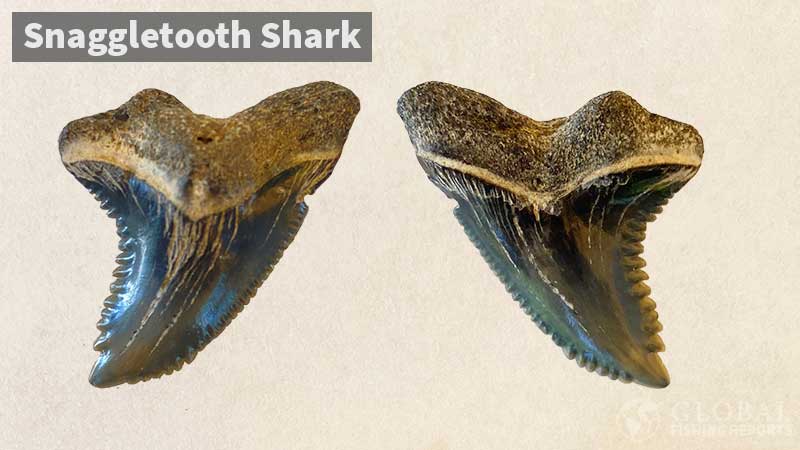
I actually thought the snaggletooth shark was extinct but I was wrong. These sharks are not found in North America but do live on the east coast of Africa, Australia, and in waters of the coast of South Asia. The rage may have extended into the USA as this tooth was found in south Florida. This is a smaller shark that is typically 4-8 feet in length which is surprising as the tooth in the picture is quite large. Perhaps millions of years ago this type of shark was larger.
Snaggletooth shark teeth are very distinct in shape as the edge of the tooth is both curved and serrated. The teeth in the front middle jaw of the shark are not this shape and come to a sharp point. However, the teeth on the lower jaw near the base keep the typical snaggletooth shark shape.
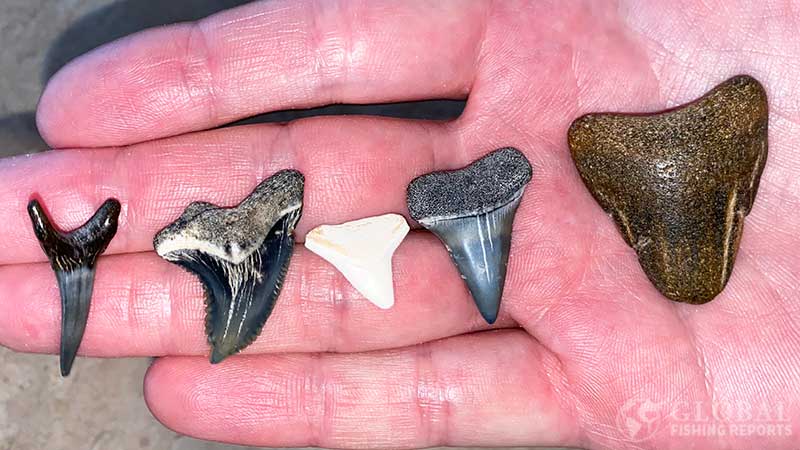
In the photo, I am holding 5 different shark teeth. From right to left the teeth are from a megalodon, great white, bull, snaggletooth, and sand tiger shark. The snaggletooth shark tooth is surprisingly large for a shark that has a max length of 8 feet. Also notice that the bull shark tooth has not been fossilized even though it was found at the beach.
Hammerhead Shark
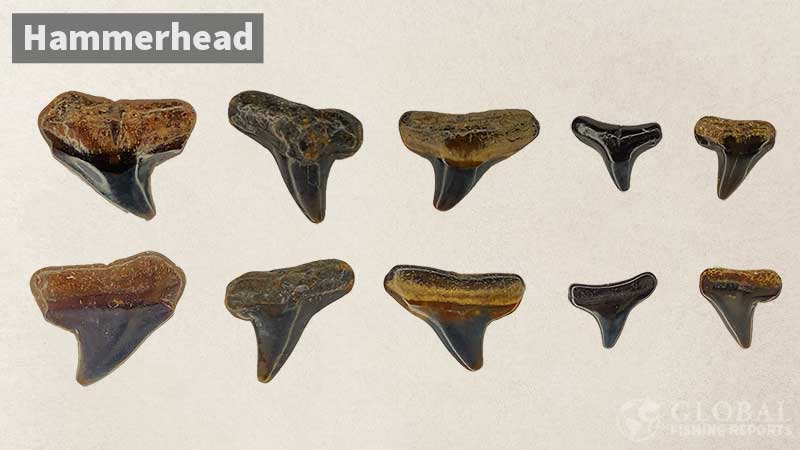
In the picture above the top row is the front of the hammerhead teeth. The bottom row is the back of the same teeth. The great hammerhead sharks can grow to be over 19 feet long and weigh over 1,200 pounds. Large great hammerhead sharks are known for eating stingrays, tarpon, and even other sharks.
Even though the shark is large the teeth are actually quite small. The shape of a hammerhead tooth can vary but they all have the same general shape. One side of the tooth has a long slant that curves into a point. The other side has a much sharper near verticle slant with a concave bend. There are different species of hammerhead including the great, smooth, small eye, scooped, scalloped, and winghead shark. Each species’ range is size and teeth shape are slightly different which is another reason for the various shapes of hammerhead teeth.
Thresher Shark
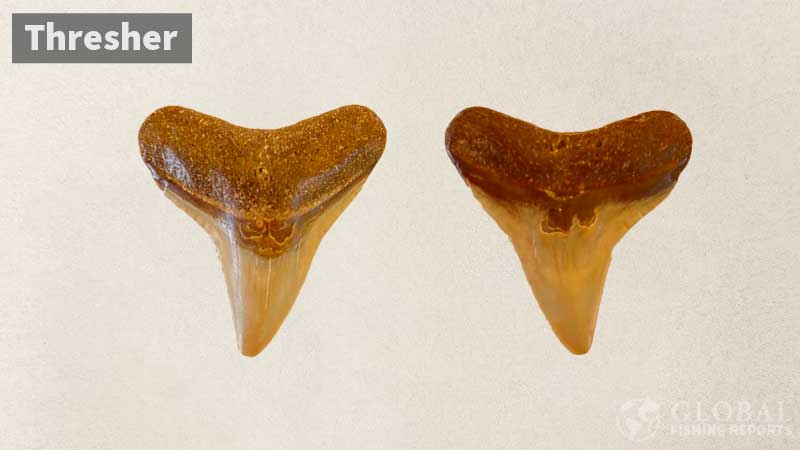
The thresher shark is known for its large tail which is actually the caudal fin. These sharks can grow up to 750 pounds and have a fork length of over 15 feet long. The caudal fin can be almost the length of the shark making the total length near 30 feet. A tooth from a thresher is similar in shape to a bull shark tooth. Where the tooth comes to a point on a thresher shark it is slightly curved and the top of the tooth is more round rather than flat.
Other Fossils
Turtle Shell
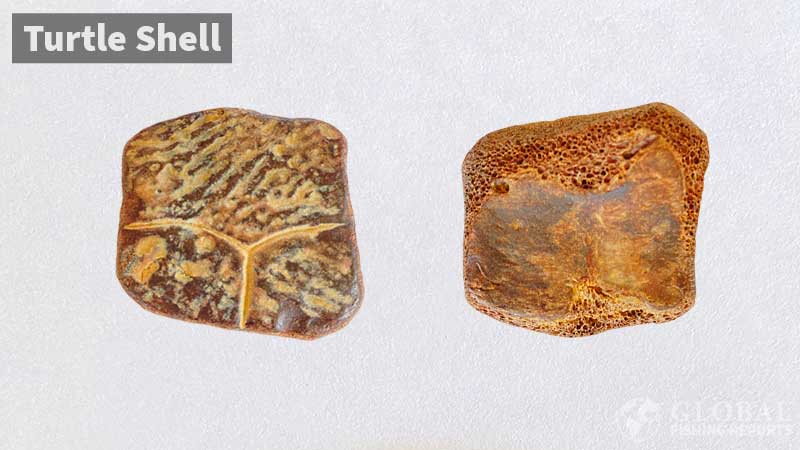
When looking for shark teeth it is common to find many other fossils as well. The picture above shows a piece of a sea turtle shell. Sea turtles have been around for around 110 million years so it is not uncommon to find fossilized shell material. In the picture, the left side shows the top of the shell and the right image shows the bottom of the shell.
Pufferfish Mouth plate
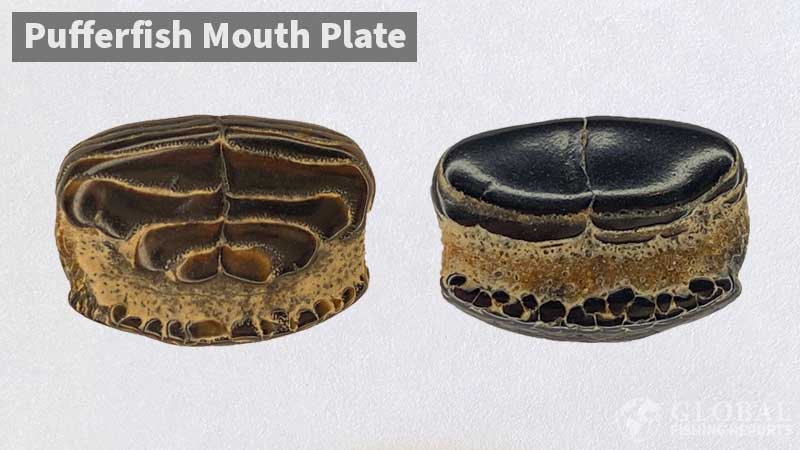
The picture above shows a pufferfish mouth plate. When looking at the mouth plate it is initially confusing as to the orientation of it relative to the fish. This would basically be the top or lower jaw of the fish. The left image is the inside of the mouth the right image is the outside. The teeth are located along the front which in this case is the bottom.
There are over 193 species of pufferfish so the mouth plate size and shape will vary. Other fish that have mouth plates include burrfish, parrotfish, and sheepshead.
Finding Fossils
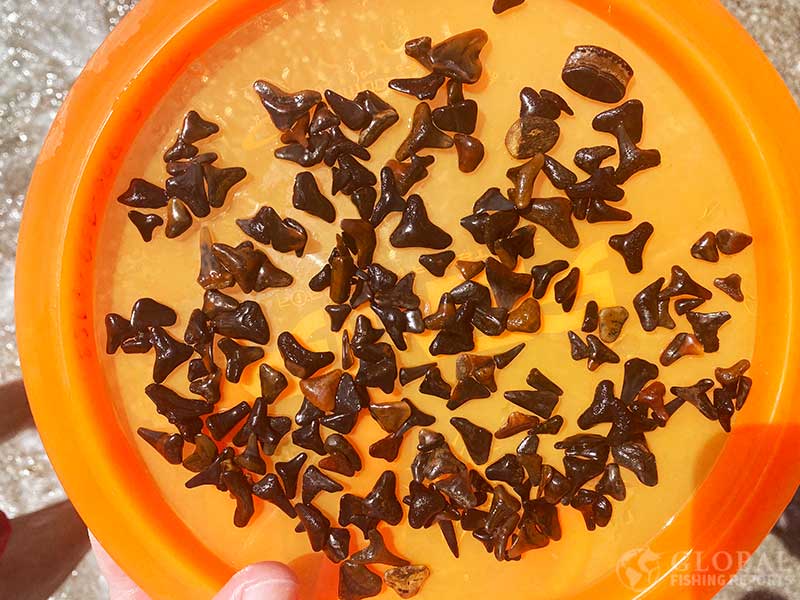
The photo above shows over 100 shark teeth as well as a pufferfish mouth plate. These were all found on a beach in Florida. I wrote a separate article on how to find shark teeth. On a recent trip to the beach, we averaged over 30 shark teeth per person every hour we spent looking. We were looking in the surf so many of these teeth are worn down but they are shark teeth.
Captain Cody has worked on charter fishing boats in the Florida Keys, Virgin Islands, and Alaska. Growing up in Pennsylvania Cody has also done extensive freshwater fishing including bass fishing tournaments. Cody strives to provide detailed information about the best fishing gear and tactics to help both novice and experienced anglers have a more productive and enjoyable time on the water. Cody also has a background in aerospace engineering and neuroscience but really only takes pride in being good at one thing and that is fishing!
How to Find Shark Teeth on the Beach
Finding shark teeth at the beach is a super fun activity for people of all ages. If you know where and how to spot the teeth it is actually not difficult to find them. The last time we went to the beach with three people in south Florida we found 320 teeth in around 3 hours. This means we averaged over 30 teeth per person per hour. We found teeth using multiple techniques which will be discussed in this article.
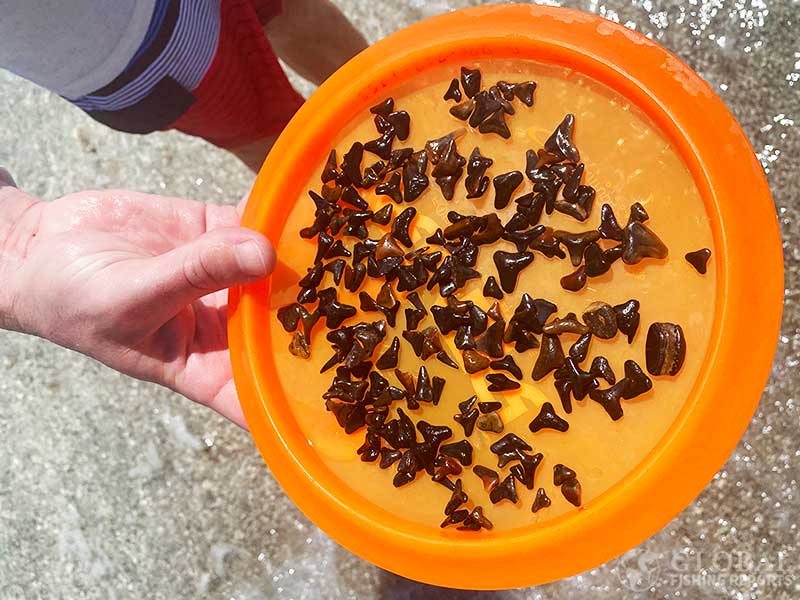
Anyone is allowed to find and keep shark teeth on public beaches in Florida. Many other types of larger fossils require special permits but there are so many shark teeth that there was an exception made to standard fossil regulations. This makes it so people can go to the beach to relax and also look for teeth as a fun activity. It is most fun when you actually find teeth so knowing the different techniques can allow you to have more success. Once people start to find them they often want to try and step up their skills to locate bigger teeth or find other unique fossils.
Walking the Beach
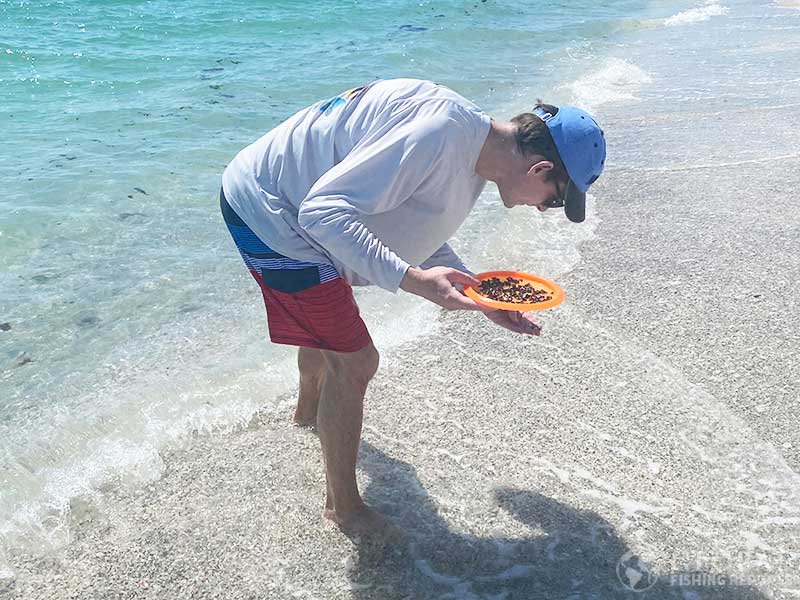
Walking the beach is the most popular way to find shark teeth. This is because it is easy and has a high chance of success. However, it does take a while to train your eyes and mind to spot teeth that are mixed in with shells, rocks, coral, and dark sand. If you do it for a few hours you might even start to look for them on your floor when you get home as well.
The best way to find shark teeth when walking the beach is to find them tumbling in the surf. After a wave crashes the beach the surf goes back and drags sand with it exposing teeth that were not able to be seen previously. Also, the teeth stand out when they are tumbling. Just make sure the water is shallow enough that it will be exposed once the wave retreats. Shark teeth are typically dark brown and in the shape of a triangle. Also, they tend to be a bit shinier than the sand and rocks.
Difficult Sand to Find Shark Teeth
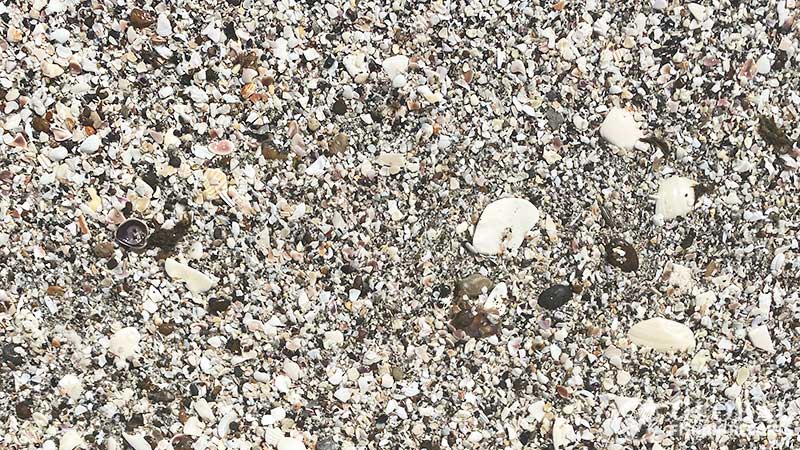
It is difficult to find shark teeth in the sand like in the photo above. This is because there are too many shells and small black rocks. It is tempting to look in these types of areas as this is where large objects congregated. Since this is the case most people would think shark teeth are also in this location. There are some shark teeth here but they are more difficult to spot among the cluttered background. I typically try to avoid this type of sand but have found some larger teeth in this type of material but not as many per hour.
Easy Sand to Find Shark Teeth

This fine sand in the surf is where I prefer to look for shark teeth. Dark objects stand out well and lots of ground can be covered quickly in theory. However, I actually like to stay in one area and have the water uncover more sand as the waves retreat from the beach.
The key to finding shark teeth is to look for really dark objects that are in the shape of a T or triangle. Shark teeth in a shark’s mouth are white and made with calcium phosphate. Shark teeth at the beach are most often really dark because they are fossilized by absorbing minerals such as iron, manganese, or other surrounding minerals in the soil.
If you look for small teeth there is a good chance you will find them, but don’t forget to also look at the larger objects as well. Some people make the mistake of only looking for large teeth and miss out on hundreds of smaller teeth they could have found.
Floating Shark Tooth Sifter

Using a floating shark tooth sifter is becoming very popular. This is because many people think this is the best way to find big shark teeth in great condition. If you go to a beach known for having shark teeth there are usually a few people in the water with the sifter. It can be attached to people with a rope and carabiner so the waves do not pull it away.
To use the sifter simply pour sand onto the top mesh. By moving the sifter back and forth the sand will fall through the cracks leaving only shells, coral, rocks, and shark teeth to look through. This makes it so the teeth can be spotted rather than buried in the sand. The shark teeth on the beach can be picked through or damaged by the surf. By going to deeper water teeth that would otherwise be difficult to see can be found.
Using a sand flea rake can be an easy way to scoop up sand from the bottom. This is because it has a long handle and filters out some of the sand before it gets to the top screen. This is good to use on calm days when the waves are not constantly crashing into you. I think you can find more teeth by just walking on the beach but you are more likely to find large unique teeth using the sifter. It is a good idea to try different areas and types of sand to see if you can locate areas with a high density of shark teeth.
Using the Surf to Expose Teeth in Buckets of Sand
Walk Into Knee-Deep Water
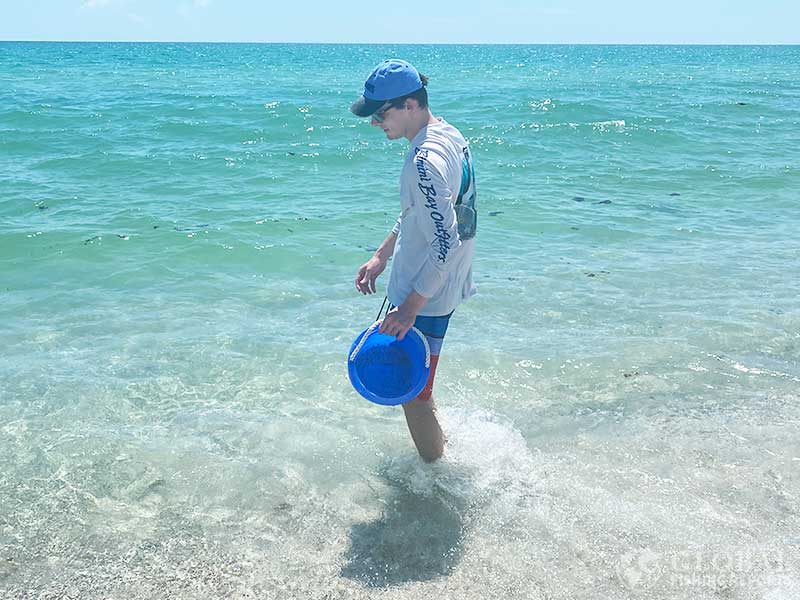
If you do not have a sifter there is another way to sort through the sand. A bucket can be used to scoop sand that is located just below the low tide line. This is where shark teeth can concentrate and most people can not look for them.
Scoop Sand Along the Ledge
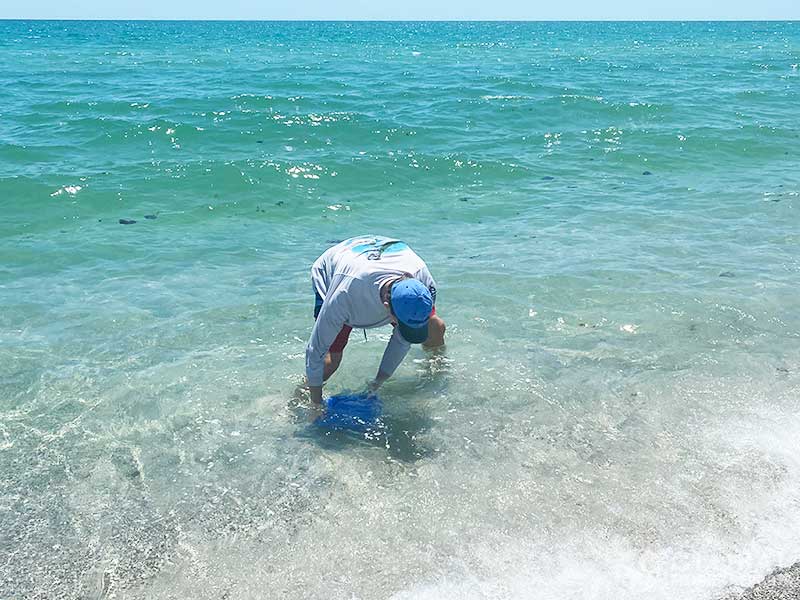
In the photo above I am scooping sand with a blue plastic bucket. I try to get sand from different depths of water to potentially find different types or sizes of teeth. Most of the time I scoop sand near the ledge of the low tide line as this is where teeth could be concentrated.
Use the Beach Surf to Filter the Sand
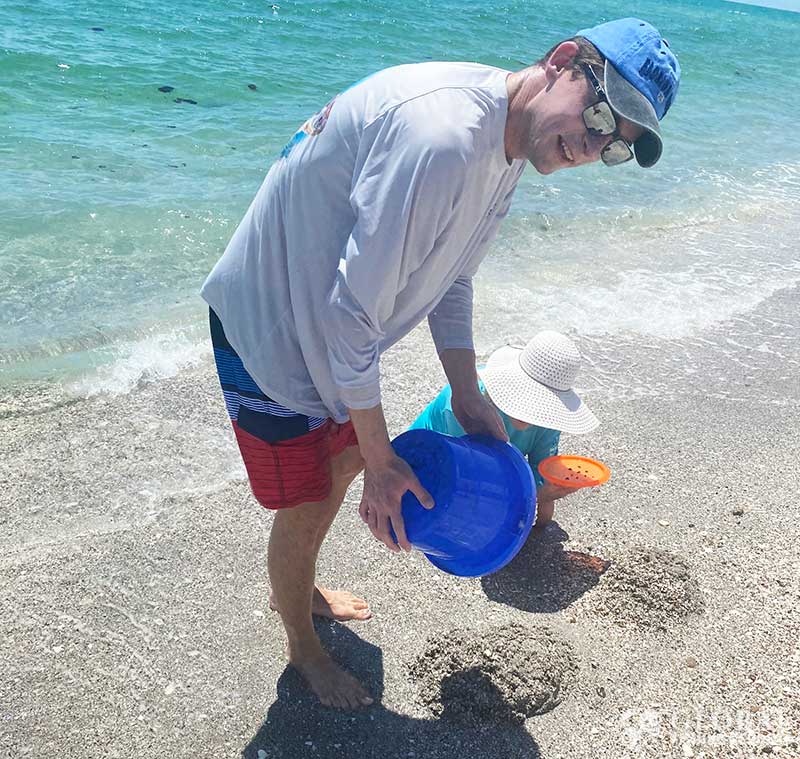
Next, the sand should be dumped at a high point on the beach but low enough that the waves still reach the sand. As the water washes over the sand and gets dispersed the teeth become exposed. You need to be on your hand and knees watching closely though. In addition to the ones you find in the sand being dumped, you can also find ones being uncovered from the main beach sand as well.
This is a simple way to find more shark teeth. Some people think you have to wait until after a storm or super low tide to find shart teeth. However, that is not the case as the sand on the beach is constantly getting washed back and forth exposing new material. The bucket method is not as easy as using a sand flea rake or sifter but definitely works to find shark teeth.
Sand Flea Rake
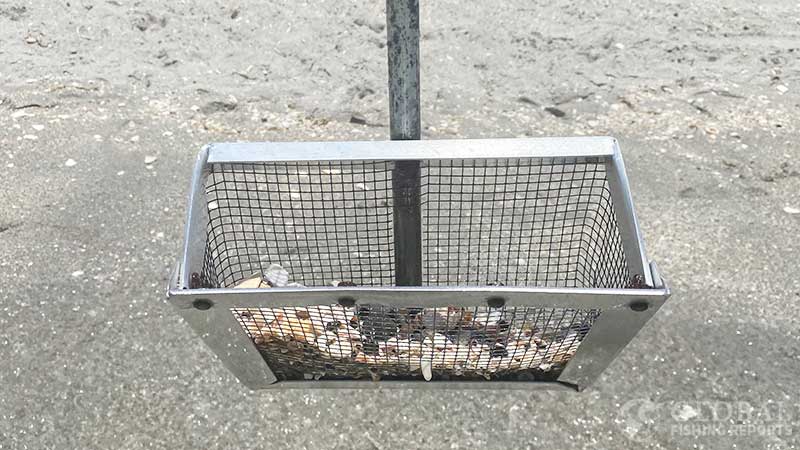
A sand flea rake is designed to catch sand fleas at the beach. Wet sand is scooped up and shaken out in the water. This leaves the sand fleas in the scoop. As a kid, we use to just dig in the sand to find plenty of sand crabs. However, if you are surf fishing then a sand flea rake can be a quick way to get natural bait.
This rake also collects shells, coral, rocks, and shark teeth. You can drag the rake in deeper water and be left only with objects large than the mesh size. Some people place this material on a sifter to sort through it. Some people dump it out under their shade umbrella and take their time looking at all the cool shells and fossils. Make sure to return the shells to the same location they were found. Leaving a pile of shells and rocks on a sandy beach is not good beach etiquette. Always try to leave the area the same or better than you found it. Throw away any trash you find while at the beach.
What To Do With Found Shark Teeth
Identify The Teeth
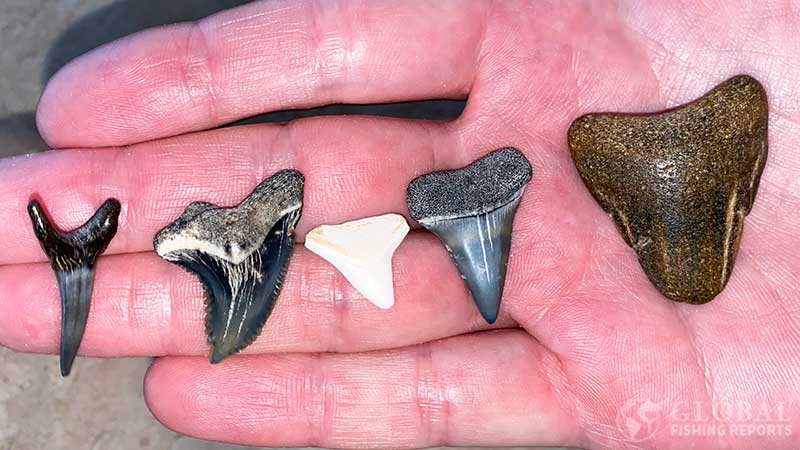
Most shark teeth can be identified by their unique shape. I wrote a separate detailed article about shark tooth identification. In the photo above from the left to right is the tooth of a sand tiger shark, snaggletooth-shark, bull shark, great white shark, crocodile teeth, mammoth ivory, and megalodon-shark.
Each type of shark has different size teeth in different areas of its jaws. Large unique teeth are easy to identify the species while smaller t-shaped teeth are common among many species of sharks. There are also over 500 different species of sharks which again can make the identification of smaller teeth more difficult. There are also other fish fossils you can find such as puffer fish mouth plates, manatee teeth, stingray teeth, barracuda teeth, whale teeth, and turtle shells.
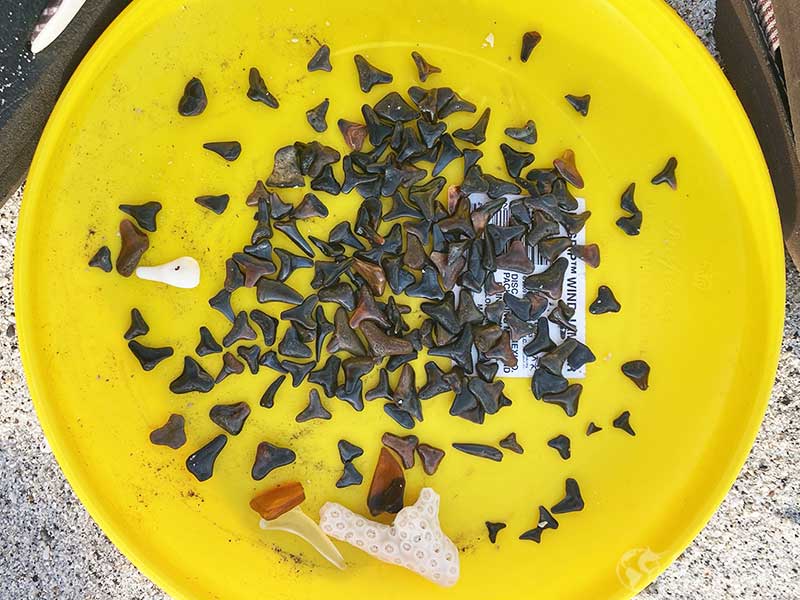
Fossilized teeth are really cool and can be millions of years old. In Southwest Florida, the geological maps show most of the beach sediments are Holocene sediments. This would suggest that most of the teeth are around 11,700 years old. However, megalodon shark teeth have been found in these areas. The megalodon shark went extinct over 3.6 million years ago. It also lived over 23 million years ago. This suggests that many of the shark teeth found are millions of years old.
Make Artwork From the Shark Teeth
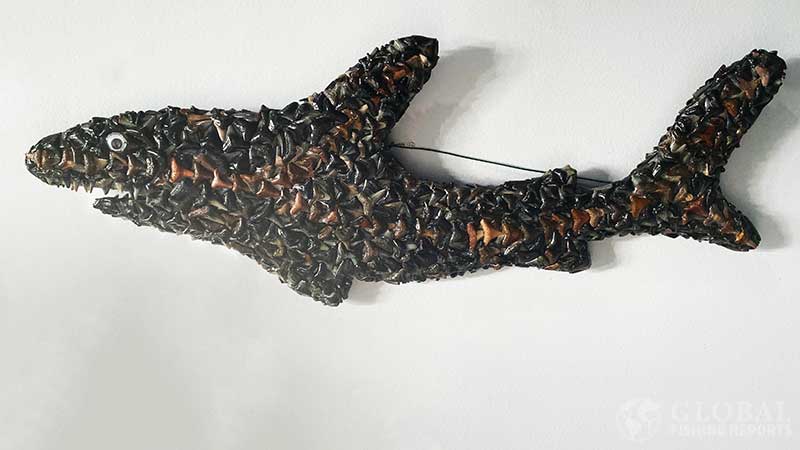
The photo above shows a decorative shark made of mostly shark teeth. Most of the teeth are small and come from lemon, blacktip, bull, and hammerhead sharks. This is just one example of what you can make with shark teeth. You could also make a necklace, bracelet, ring, or put them in a picture frame.
It is also common to store shark teeth in a glass jar. Putting shark teeth under a glass table or coffee table is another idea. Other beach items like shells and coral could also be added. A shadow box which is a thick picture frame with a glass or plastic cover could be used to make a shark tooth arrangement. A picture of the beach where the teeth were found could be used as the background to cherish your memory.

The photo above shows a shark painting where the shark is made of shark teeth. The painting is blue and white to look like the ocean.
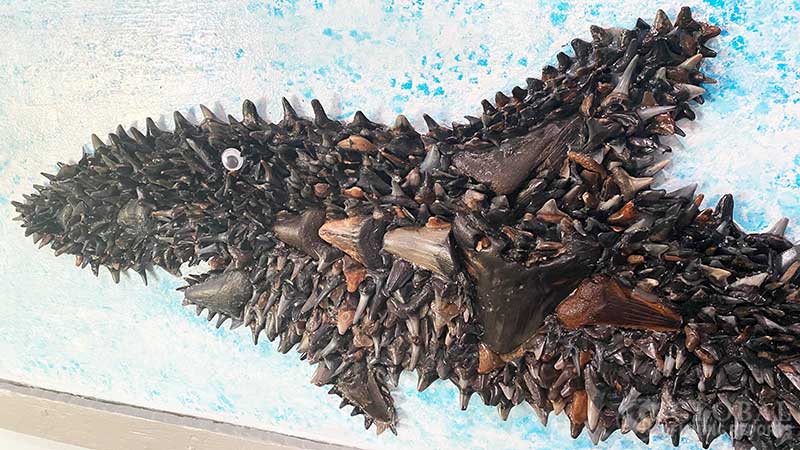
Here is a close-up view of the shark painting. This shark is made with the teeth of a megalodon, sand tiger, blacktip, lemon, tiger shark, and hammerhead shark. This makes it a really unique piece of art as many of these fossilized teeth are over 3.6 million years old. Larger teeth are used to make the various fins of the shark.
Where to Look for Shark Teeth

Shark teeth can be found at most beaches in the united states. They can also be found on land throughout most of Florida because there were times when most of Florida was underwater. This means that at times most of the land was previously a sea floor. Research articles show shorelines fluctuated significantly over the past several million years. At some points, the sea level was even 328 feet lower than today creating much more land, especially in the Gulf region where shallow water extends for many miles.
Other studies suggest that ocean levels were 22 feet higher than today during the last interglacial period which was 120,000 years ago. A fossil takes around 10,000 years to form so there are plenty of shark teeth fossils that can be found on dry land in Florida. So in some areas where they are excavating four new home construction, they will find shark teeth. These teeth belong to the land owner if they are on private land. You can get in trouble if you are fossil hunting on private land.
Since Florida was underwater for large periods of time the entire state is a popular place to look for shark teeth. Most people focus on the Beaches of Florida’s Gulf Coast although they can be found throughout the state. They can actually be found on most other beaches as well. Beaches in Georgia, South Carolina, Georgia, and Texas are also popular places to find shark teeth. The more sarks that do or did live in the area makes it more likely you will find teeth there.
If you have ever been shark fishing in Florida you know there are lots of sharks around. Florida has the highest density of sharks so it also has the highest density of shark teeth. The type and age of sediment does play into the density of shark teeth which we talked about earlier with the geological survey data. However the age of teeth found in these sediments do not always match so if you think there could be shark teeth in your area, I would suggest looking to see what you can find. At a minimum, you should be able to find some modern shark teeth if you are at any shoreline.
When Should you Look for Shark Teeth
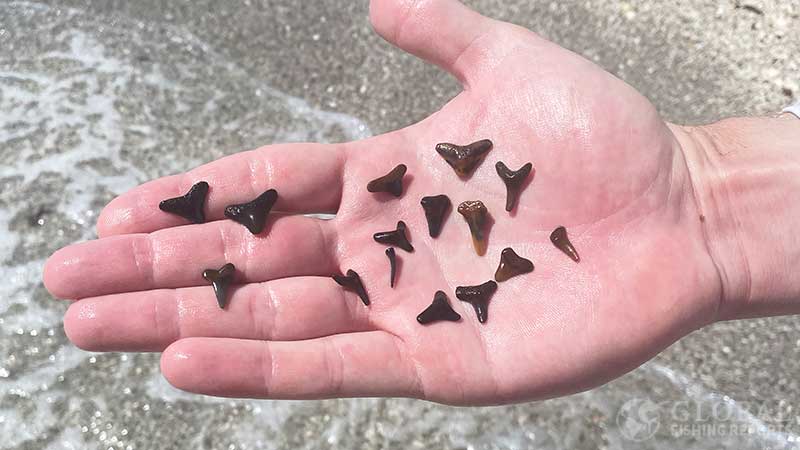
In the photo, I am holding a bunch of shark teeth we found at low-tide. When the tide is low it exposes the most amount of sand on the beach and is the best time to look for shark teeth. The tide changes about every 6 hours so there are two low tides each day. This is because there are solar and lunar tides. The time of the low tide changes each day and the time of low tide is different based on location.
So the best time to look is not in the morning or evening but is tide and wave height specific. Large waves stir up lots of sand exposing more shark teeth. Many people also suggest looking for teeth after a large storm, especially a hurricane. The storm surge and large waves bring lots of material that was in deeper water onto the beach areas. Also after hurricanes, it is common for beach excavation projects to take place where deeper sand and dirt can be dug up. Even after a thunderstorm this can happen but not to the same extent as a hurricane.
Low tides and storms can allow for a higher density of teeth to be exposed. Don’t let that stop you from looking at all times of the day. If the waves and tides are moving that means new sand is being exposed. Another good time to look is when the tide is going from high to low. As the tide line drops it should pull sand back exposing shark teeth.
Even on beaches that are loaded with people, you can still find teeth in the surf as new sand is constantly being exposed. If you think the beach is too picked through and you want to look for large teeth try and find less popular beaches or areas further from beach entrances. Walk a half-mile down the beach and then start looking.
Don’t forget to wear sunscreen as it is common to get burned when looking for shark teeth for hours. I hope this article helps you find more shark teeth. If you have other suggestions of places or ways to find teeth, leave a comment below.
Captain Cody has worked on charter fishing boats in the Florida Keys, Virgin Islands, and Alaska. Growing up in Pennsylvania Cody has also done extensive freshwater fishing including bass fishing tournaments. Cody strives to provide detailed information about the best fishing gear and tactics to help both novice and experienced anglers have a more productive and enjoyable time on the water. Cody also has a background in aerospace engineering and neuroscience but really only takes pride in being good at one thing and that is fishing!















































































Off the beach surf fishing on Sunset Beach, NC. I can’t stop stop catching Black Tips using a Mullet rig. Biggest was a 5 foot, fall of 2015.
Bob thanks for the information and for signing up to the site! I see you shared the picture on our facebook page. If you post it as a fishing report on this site, that would be awesome! If you need help figuring out how to do it, let us know.